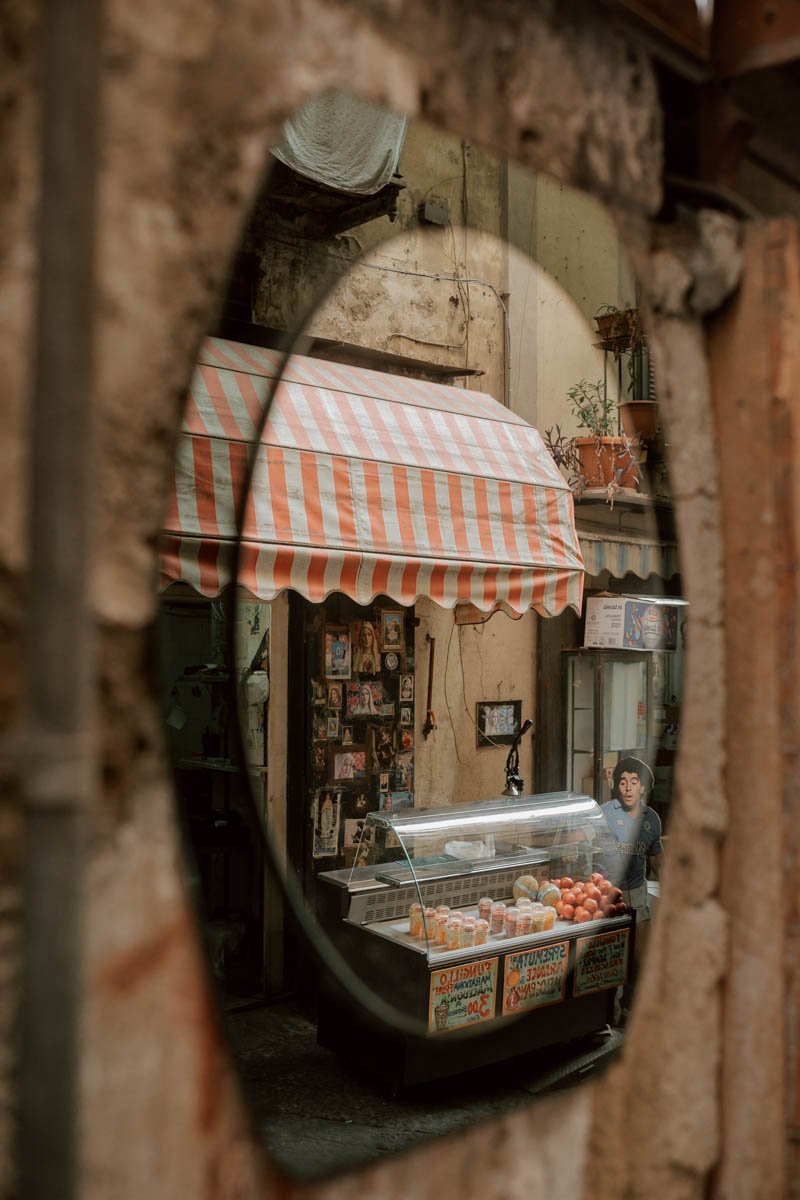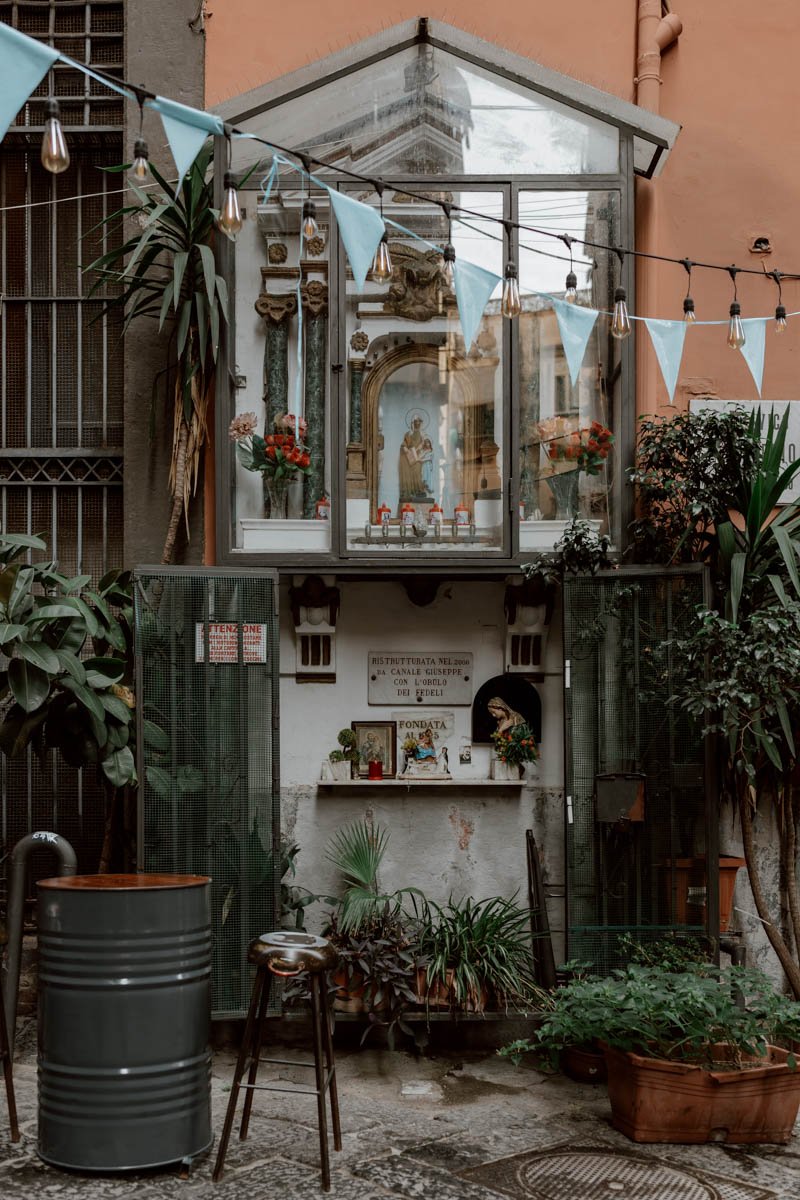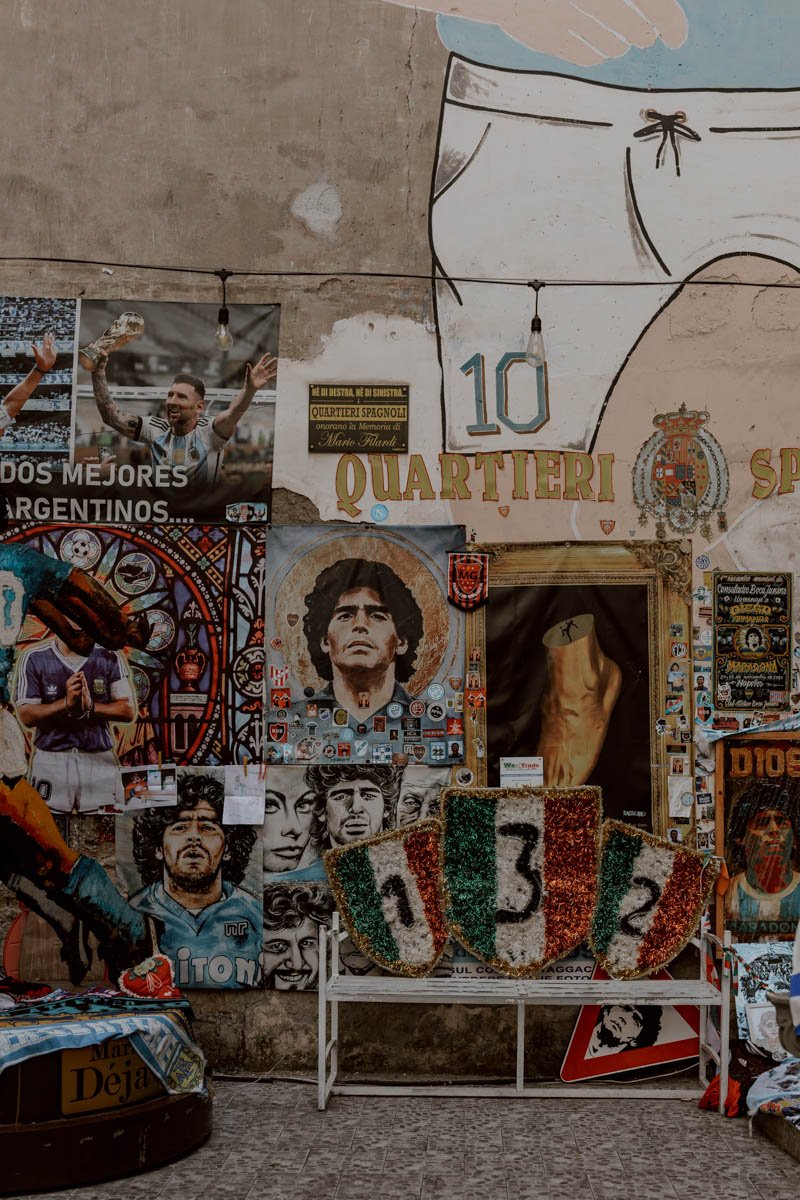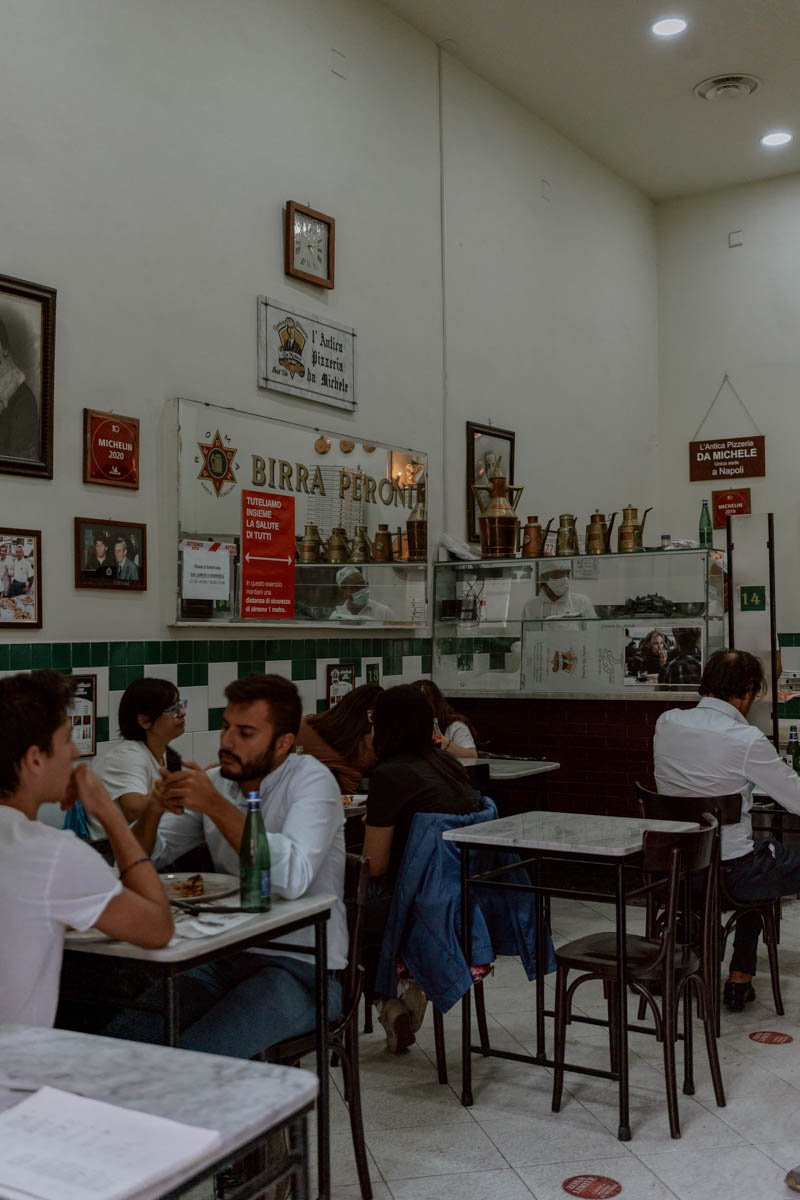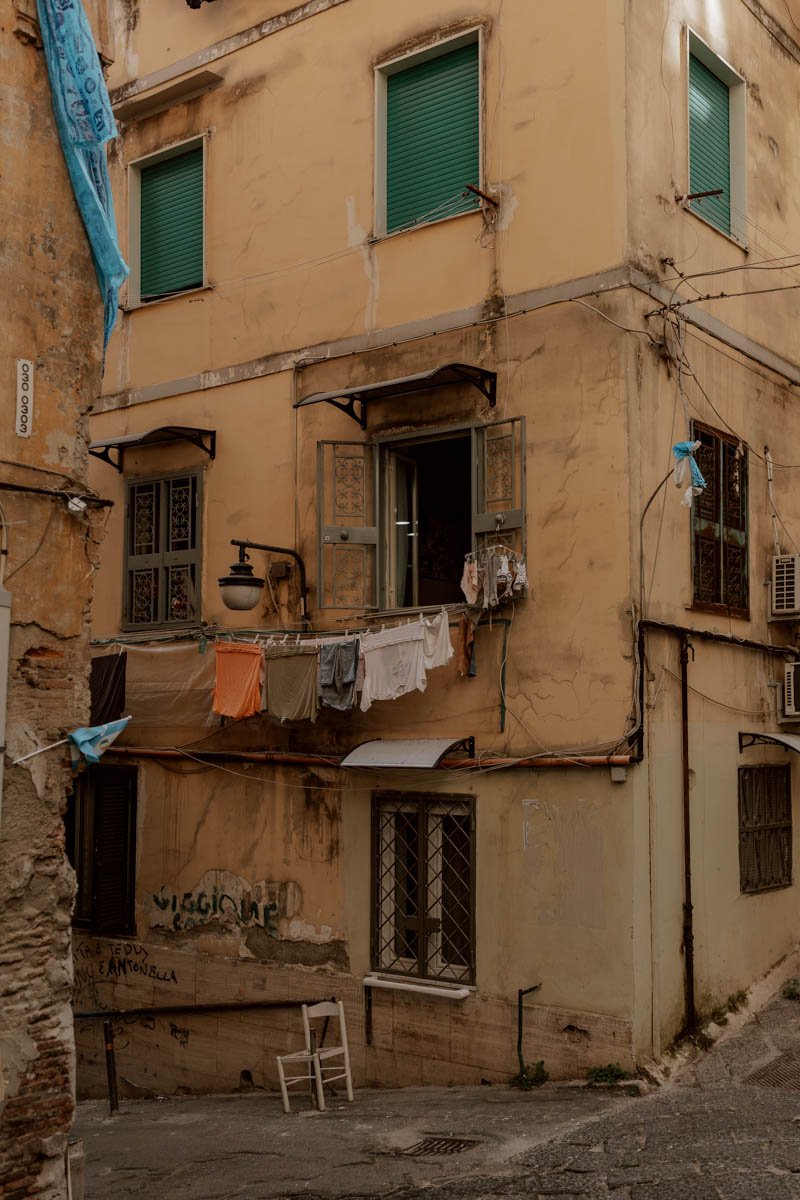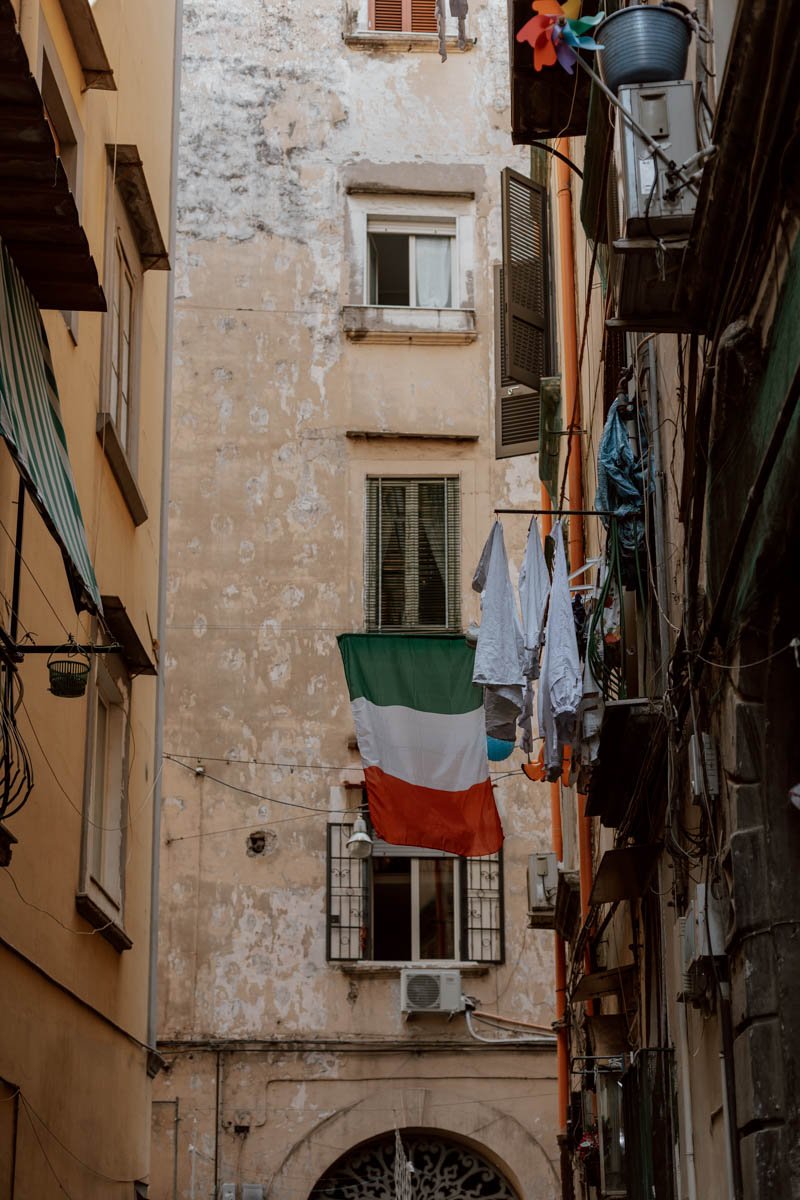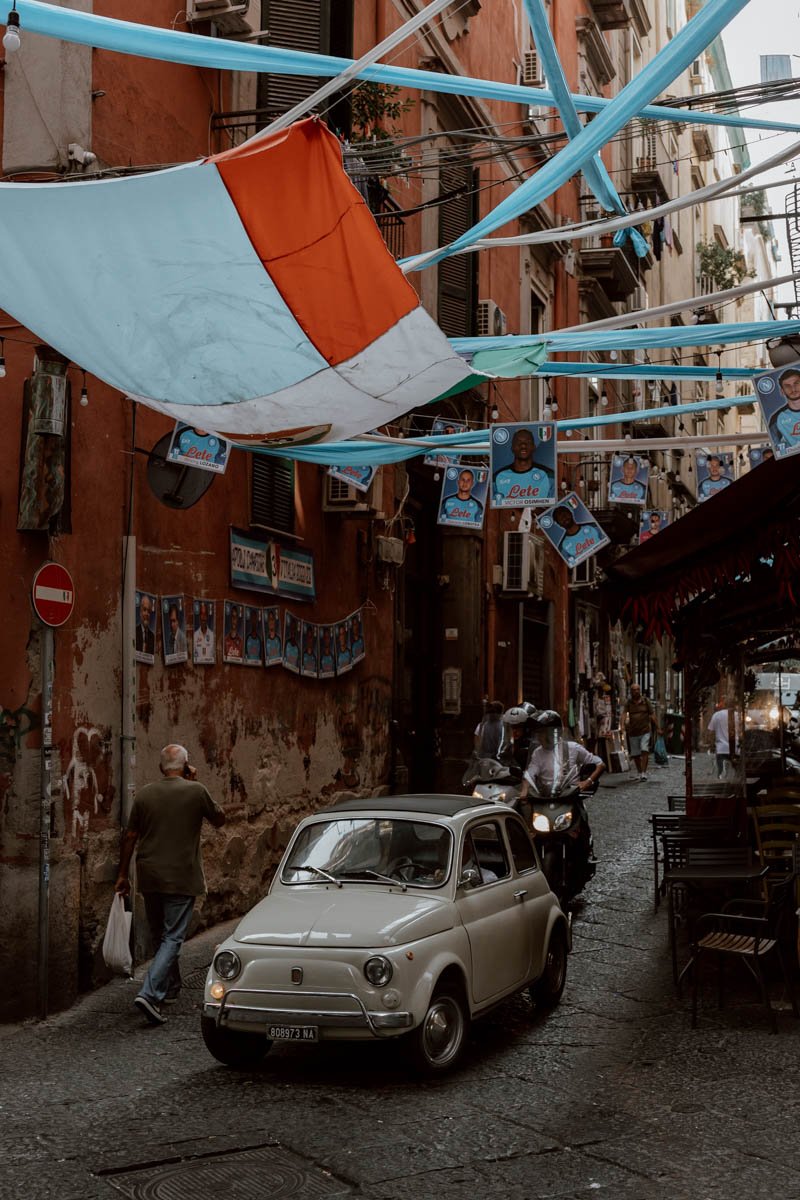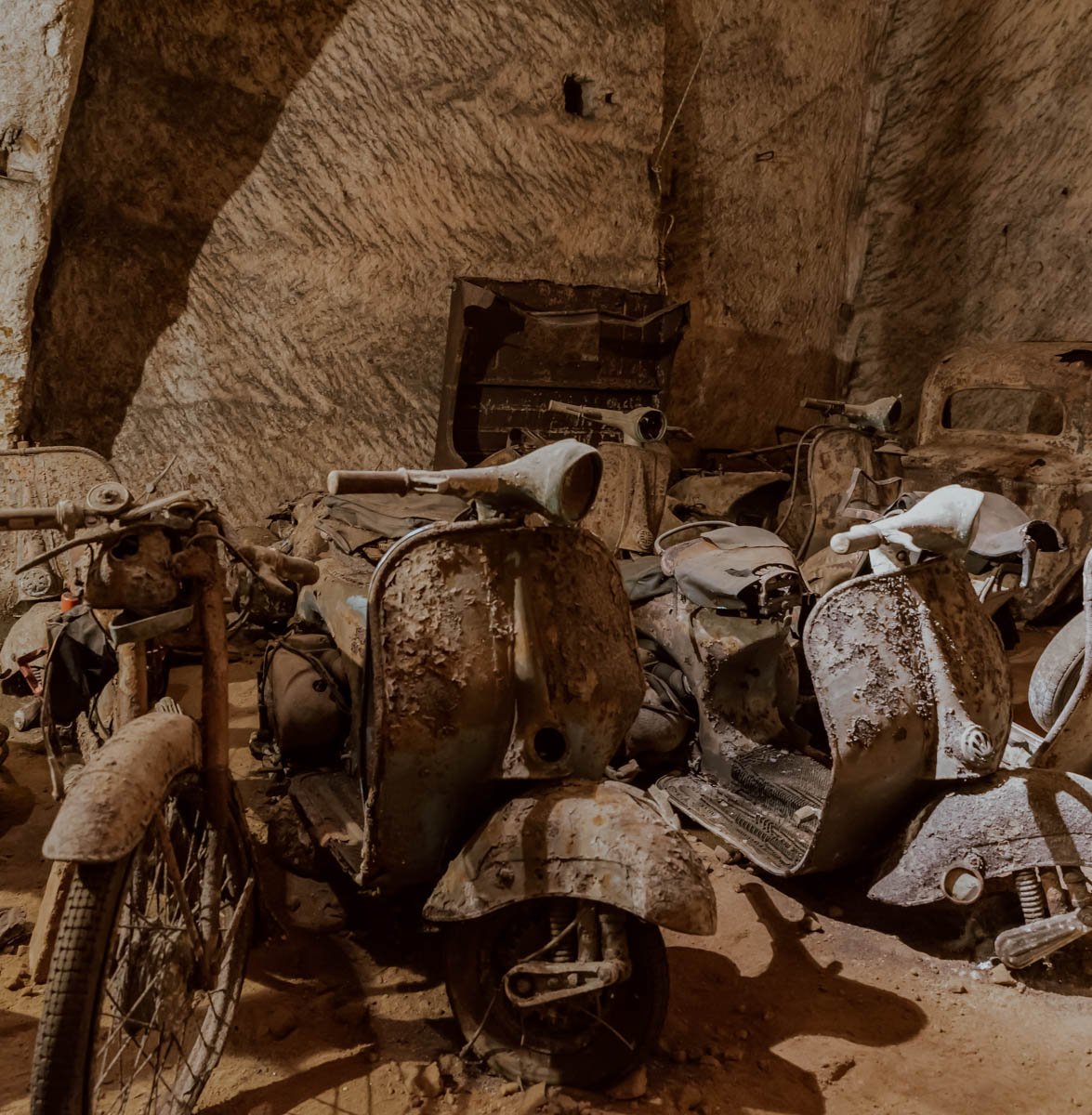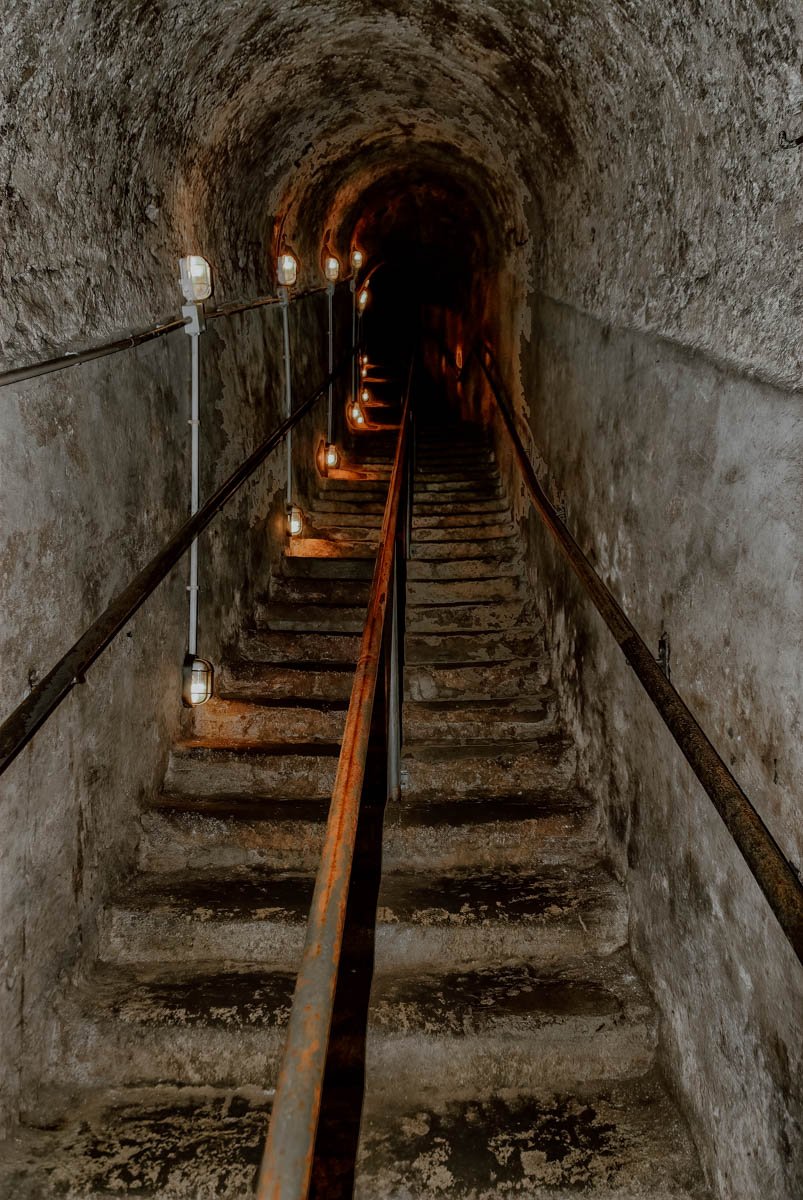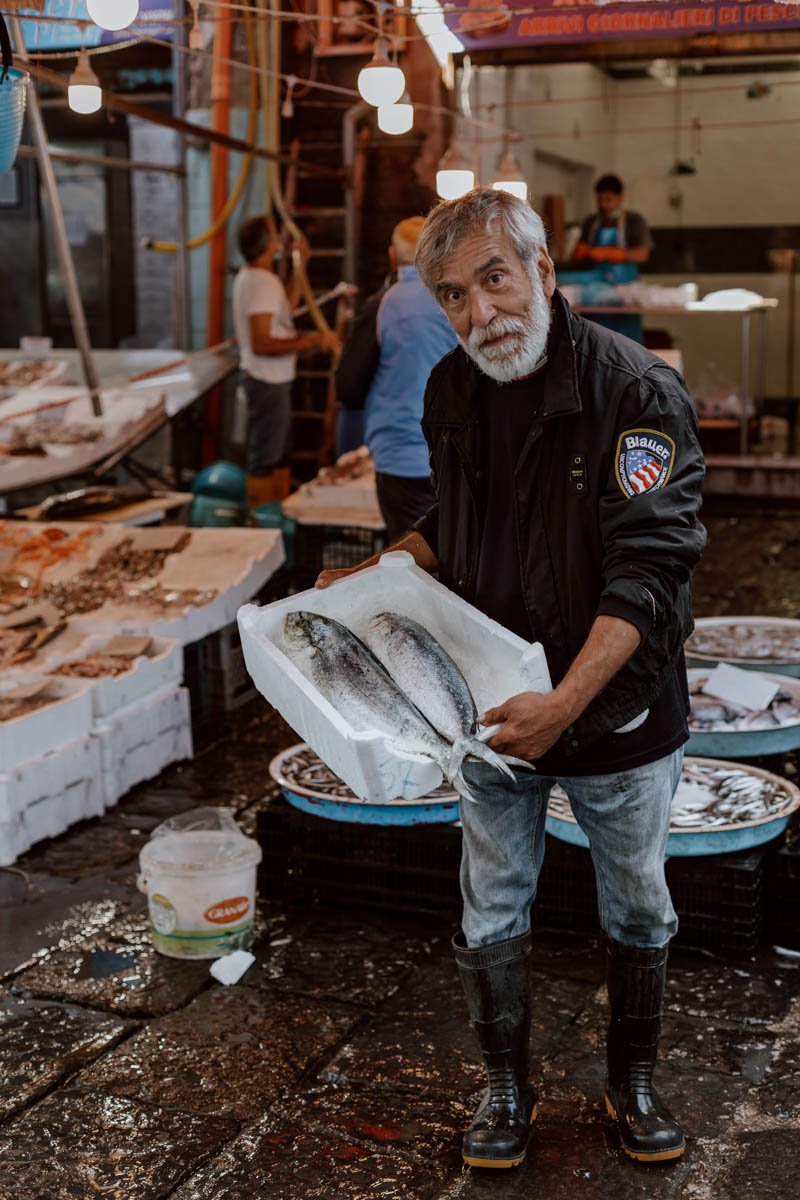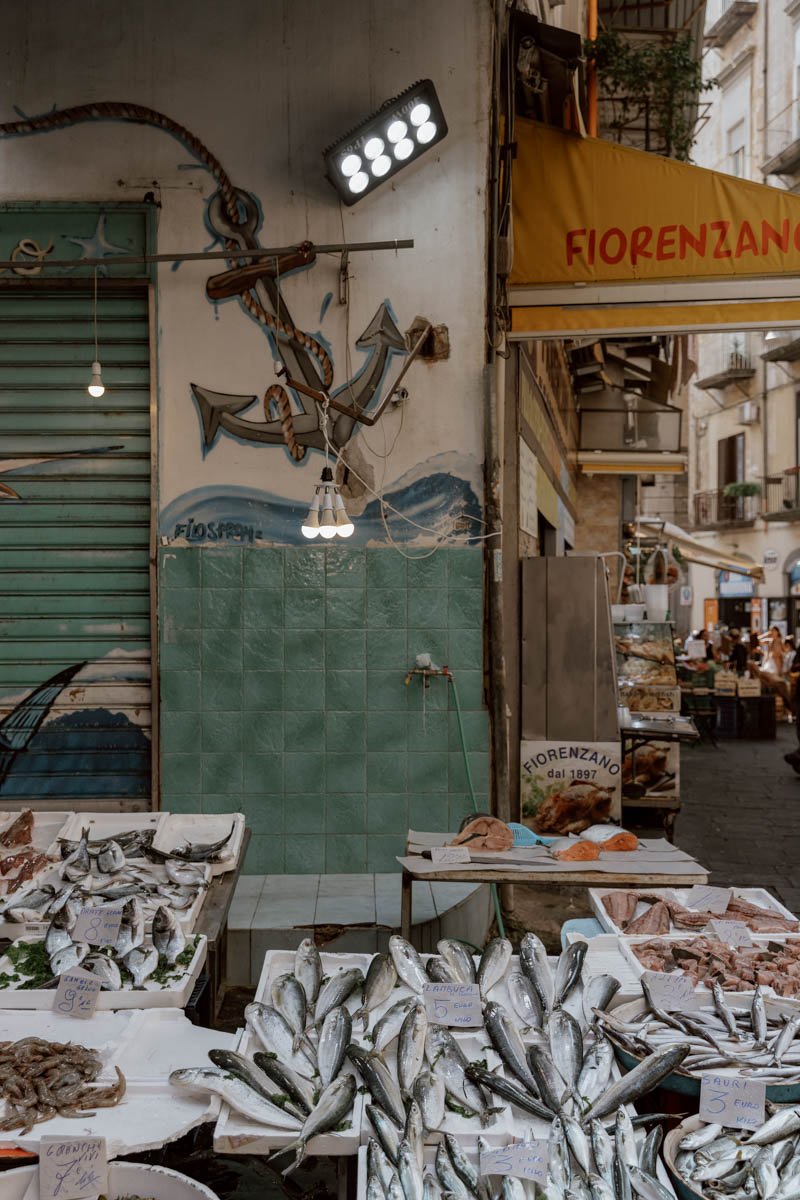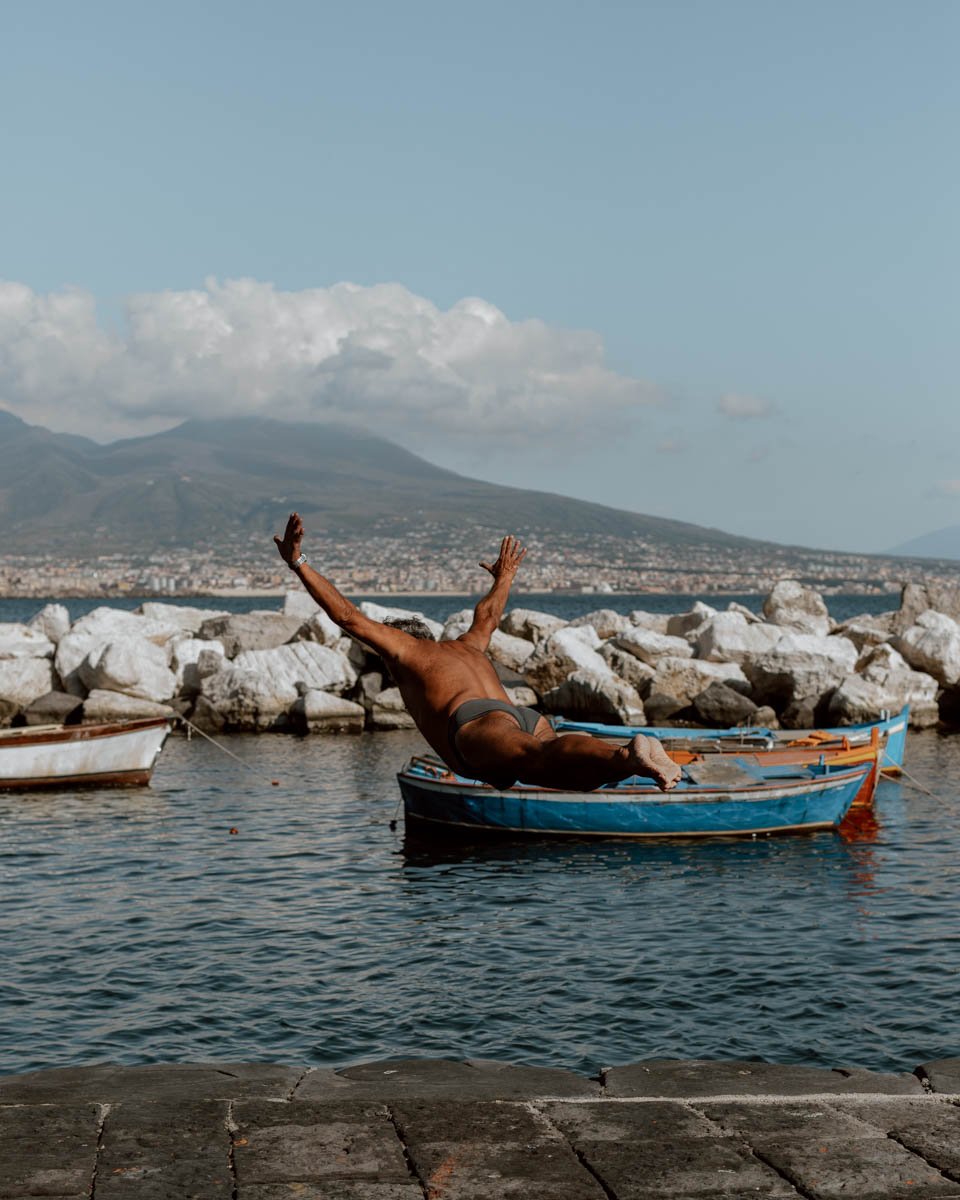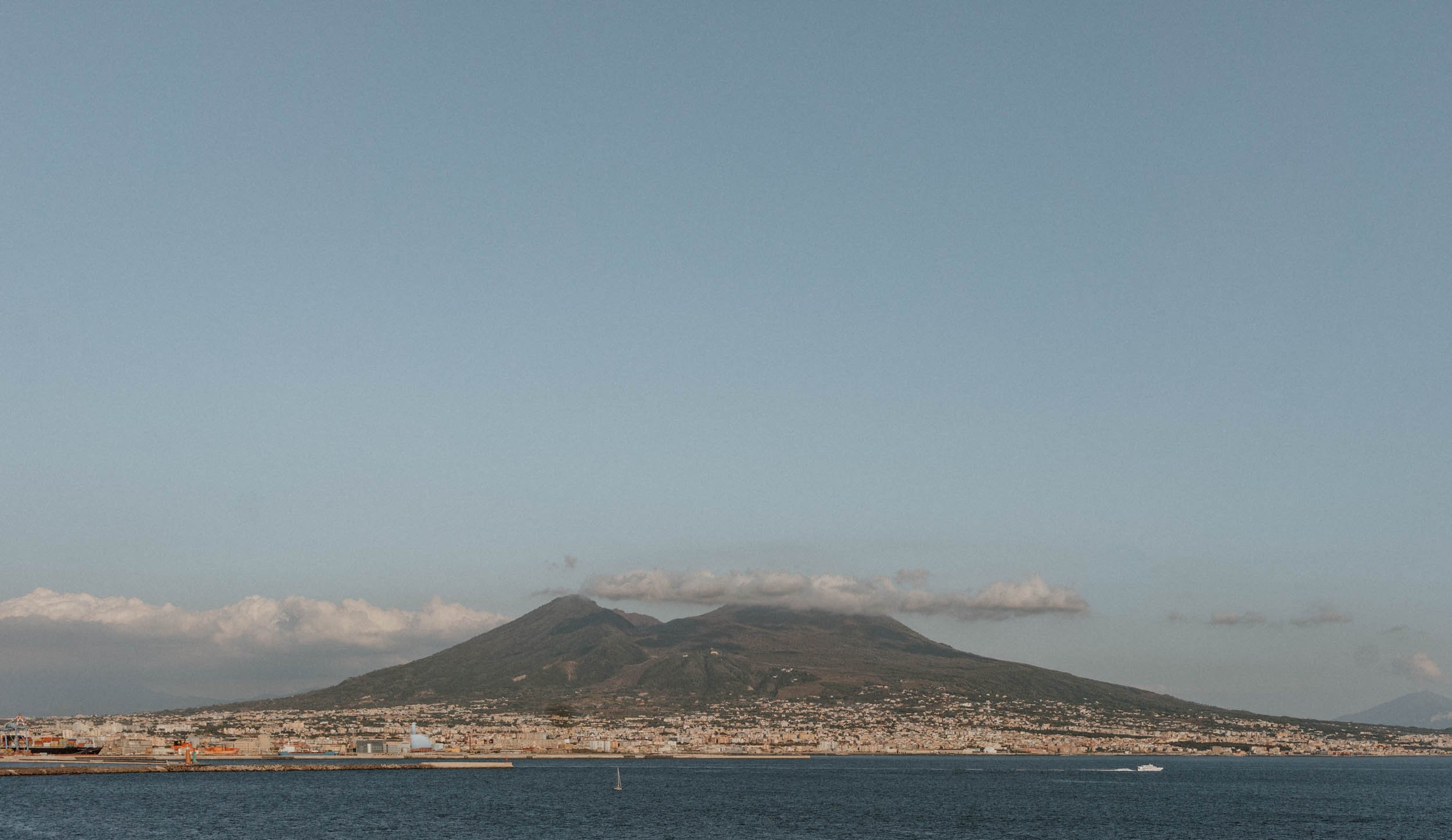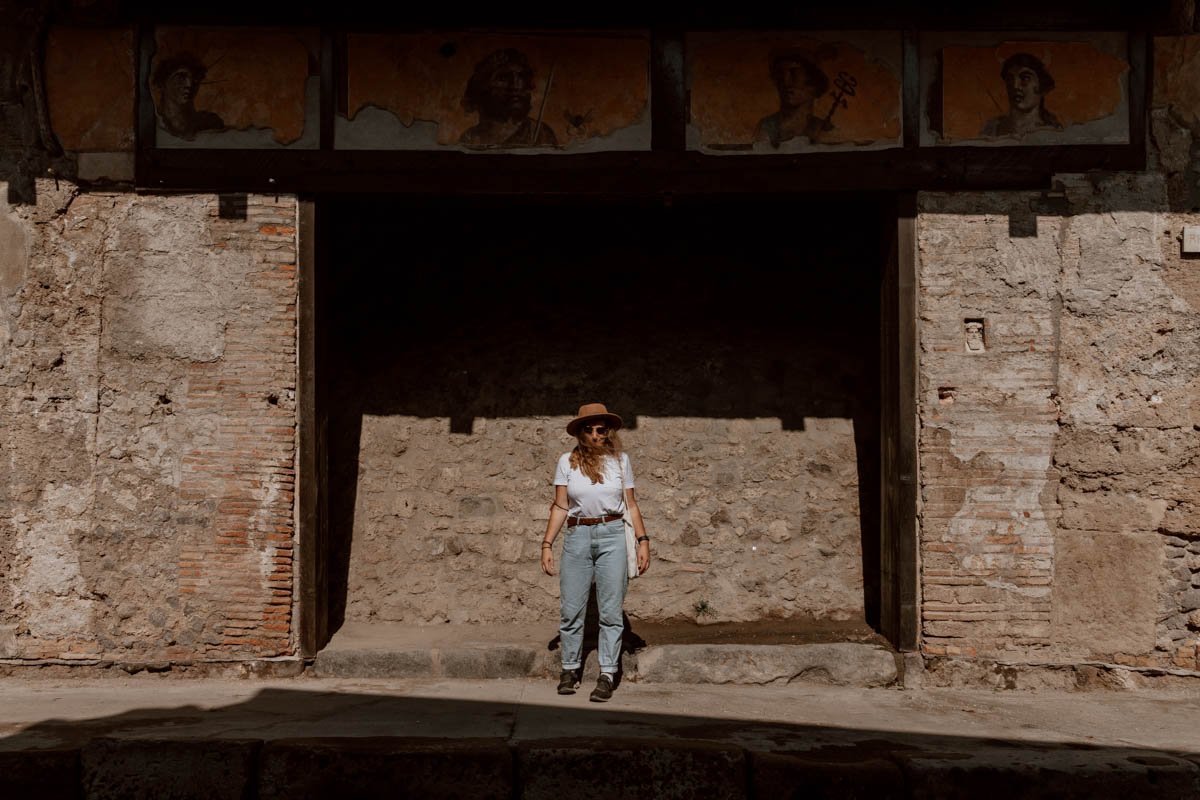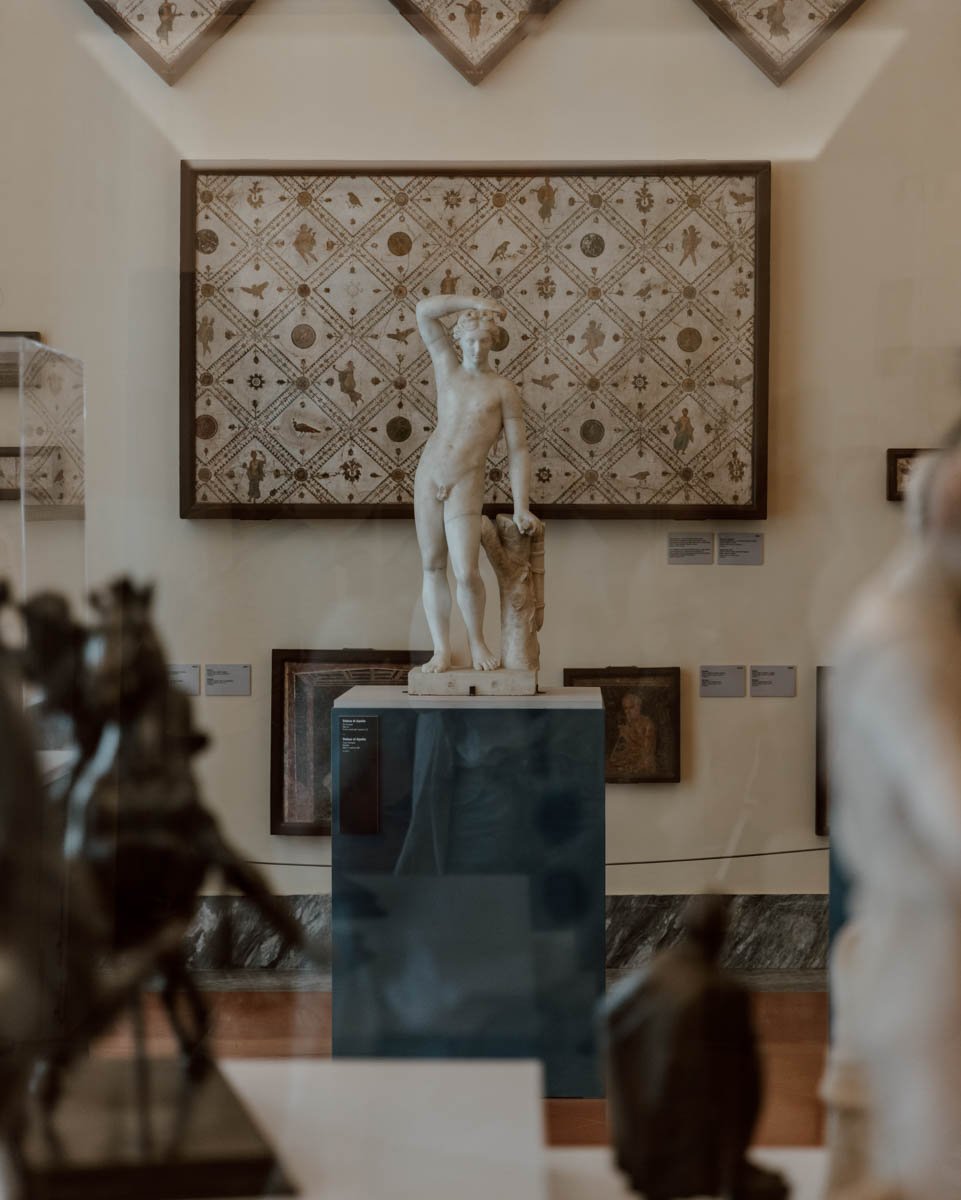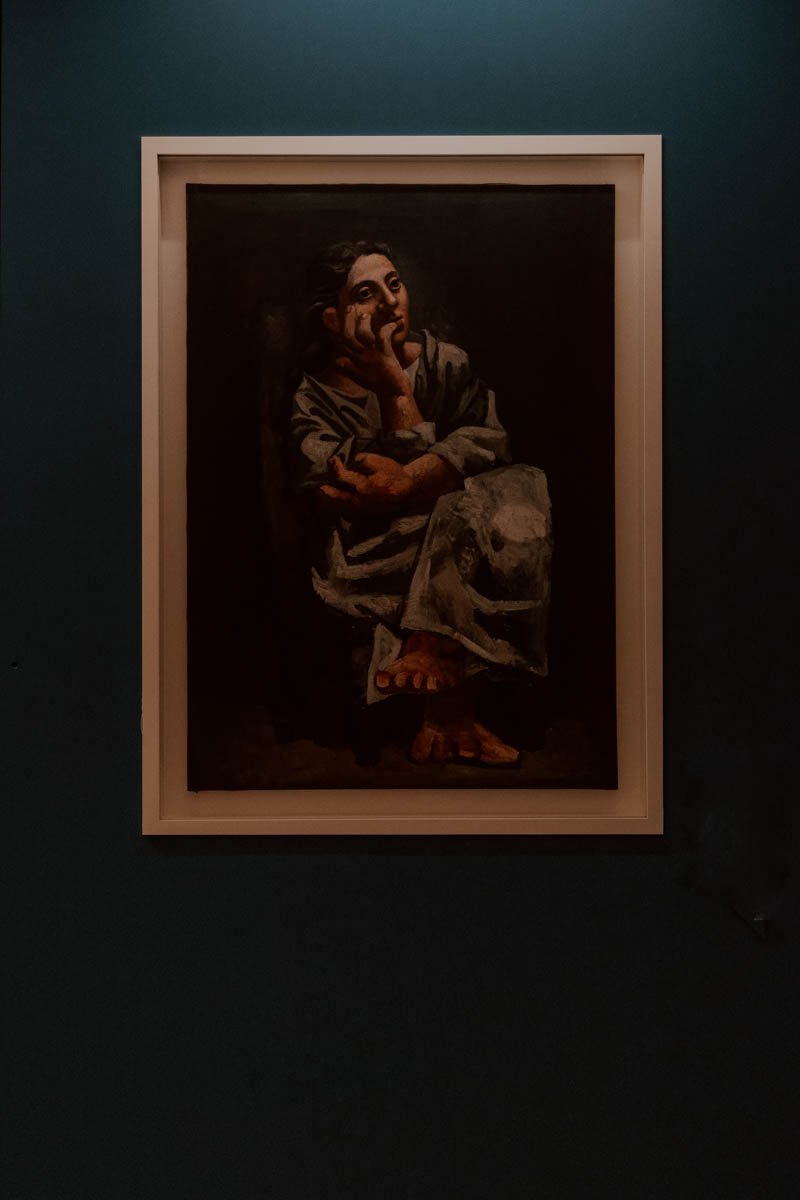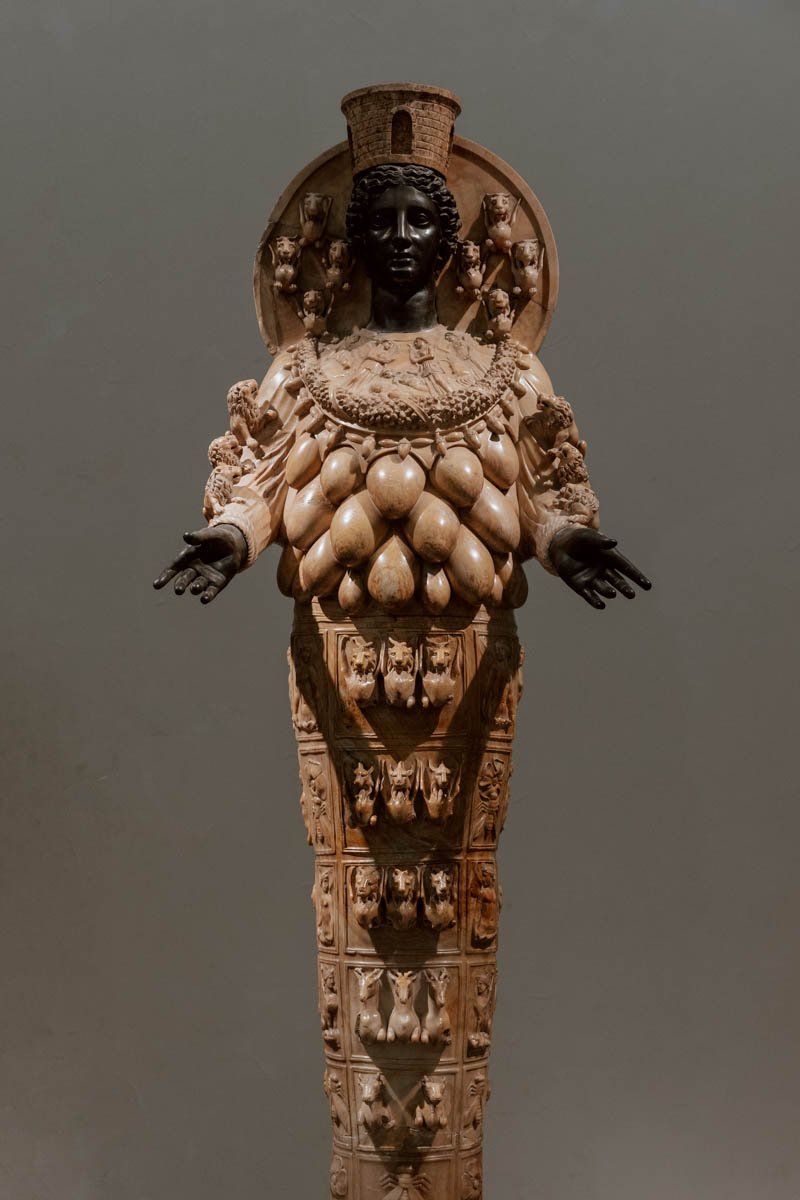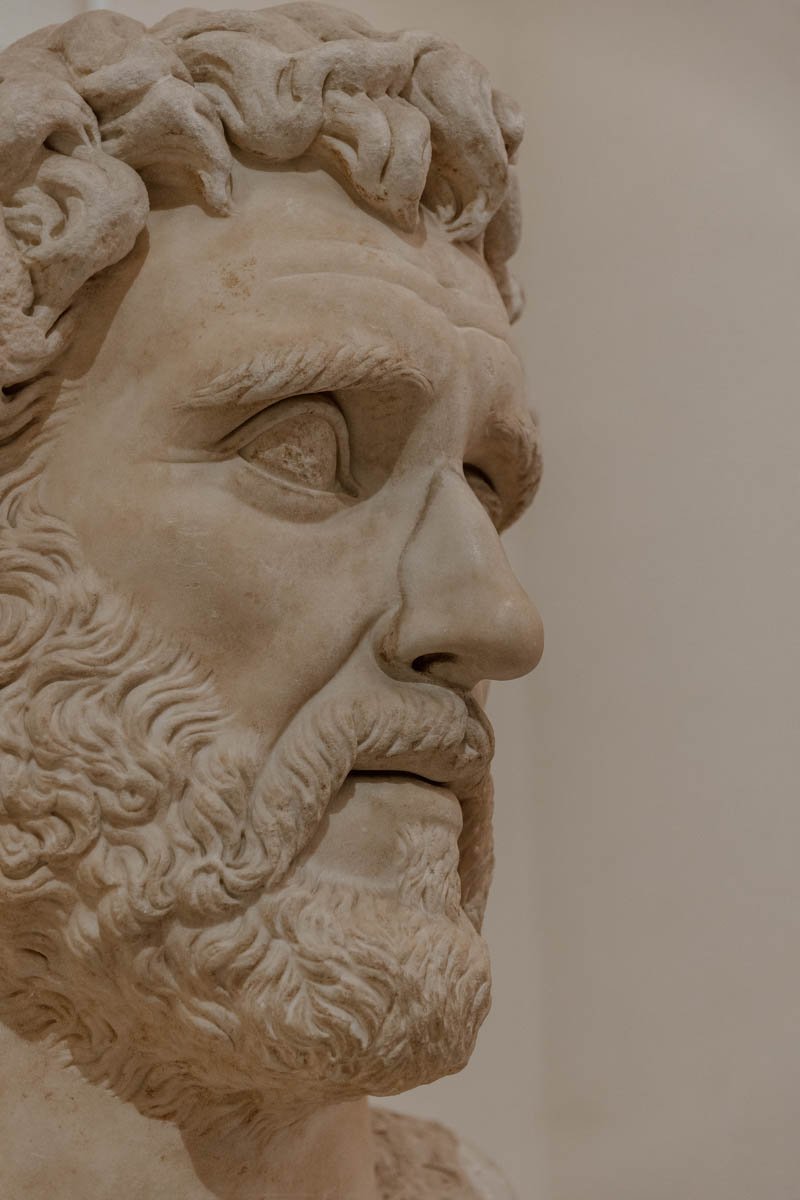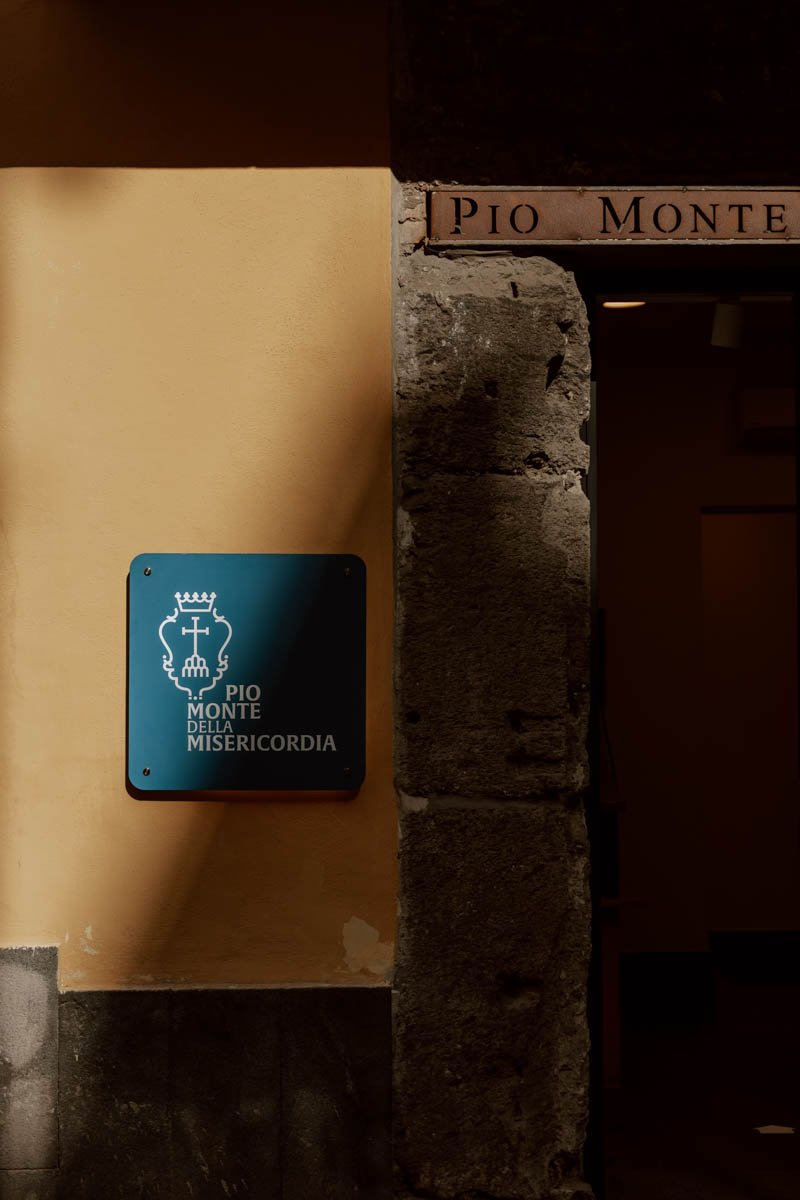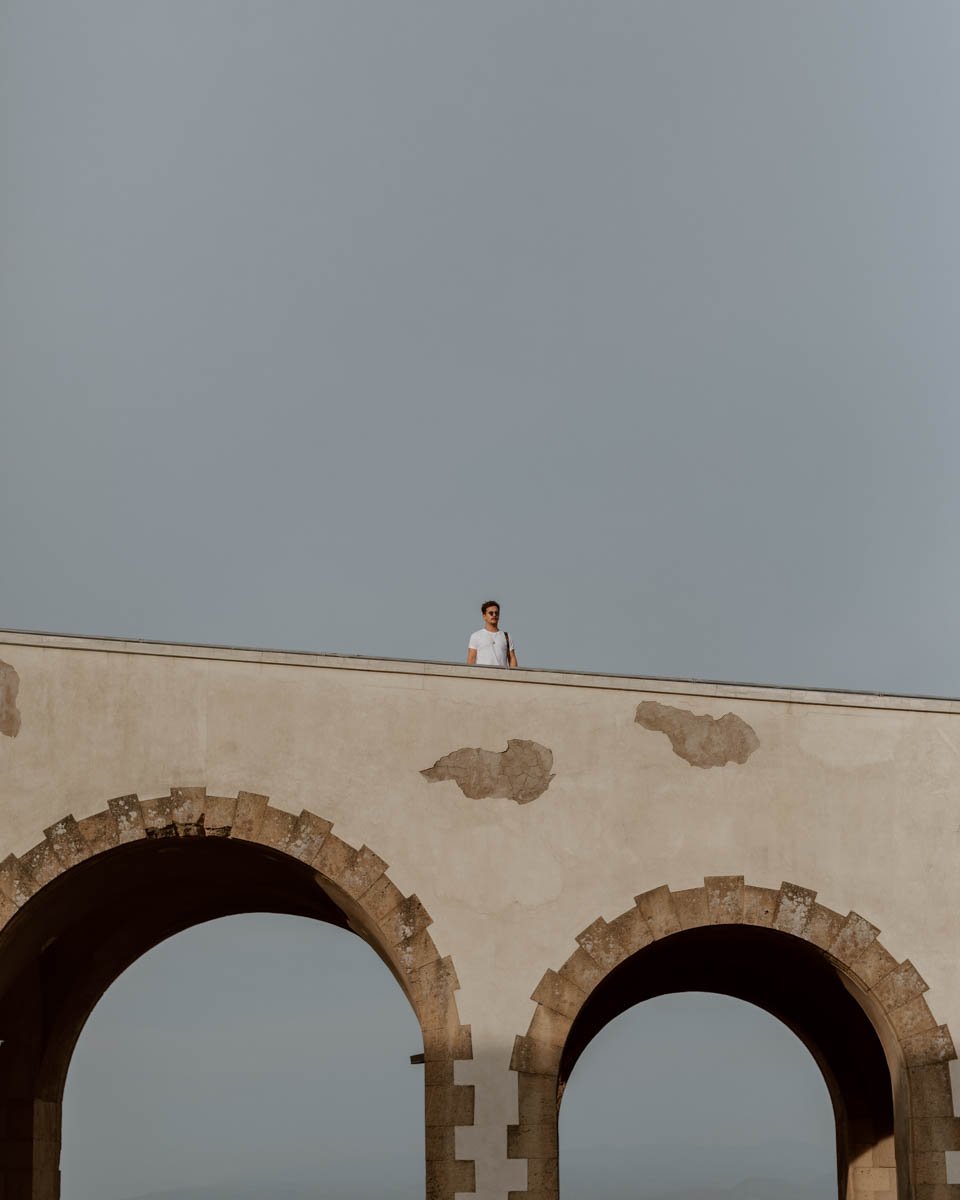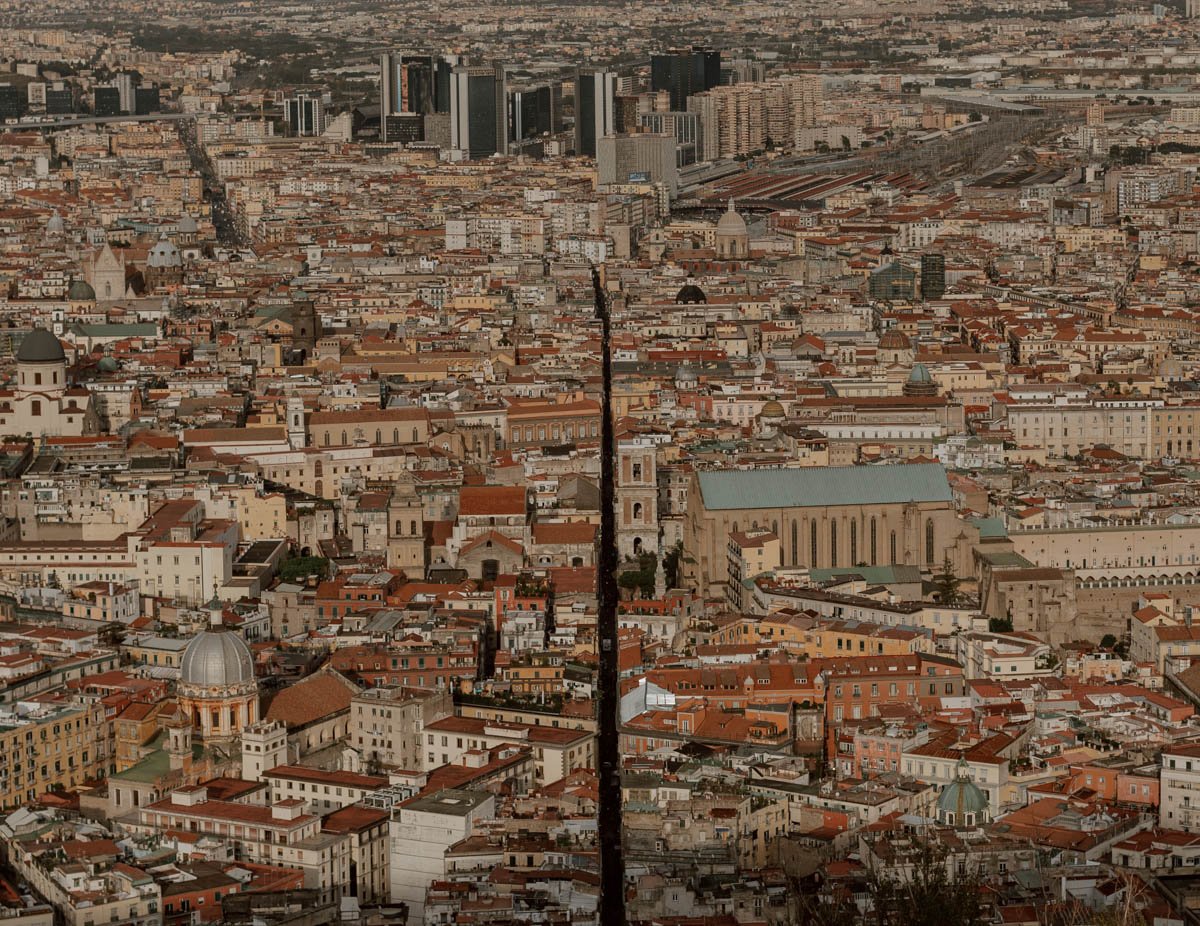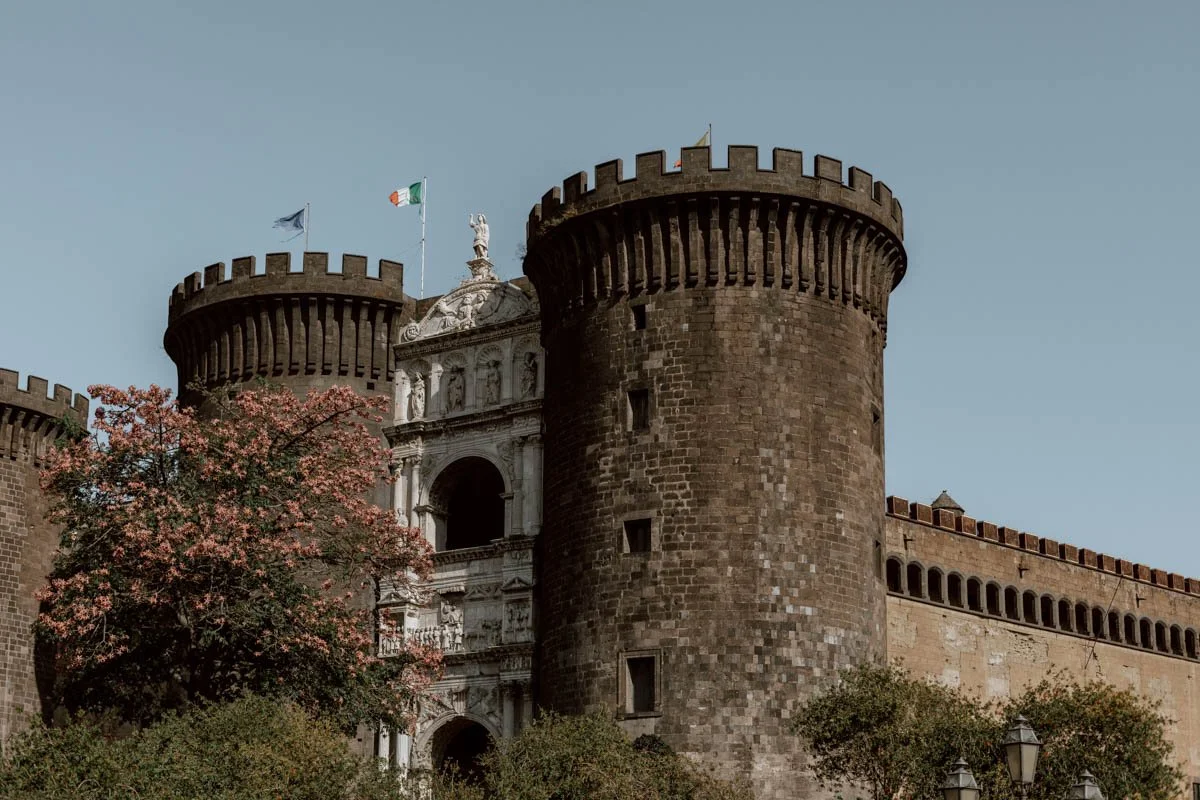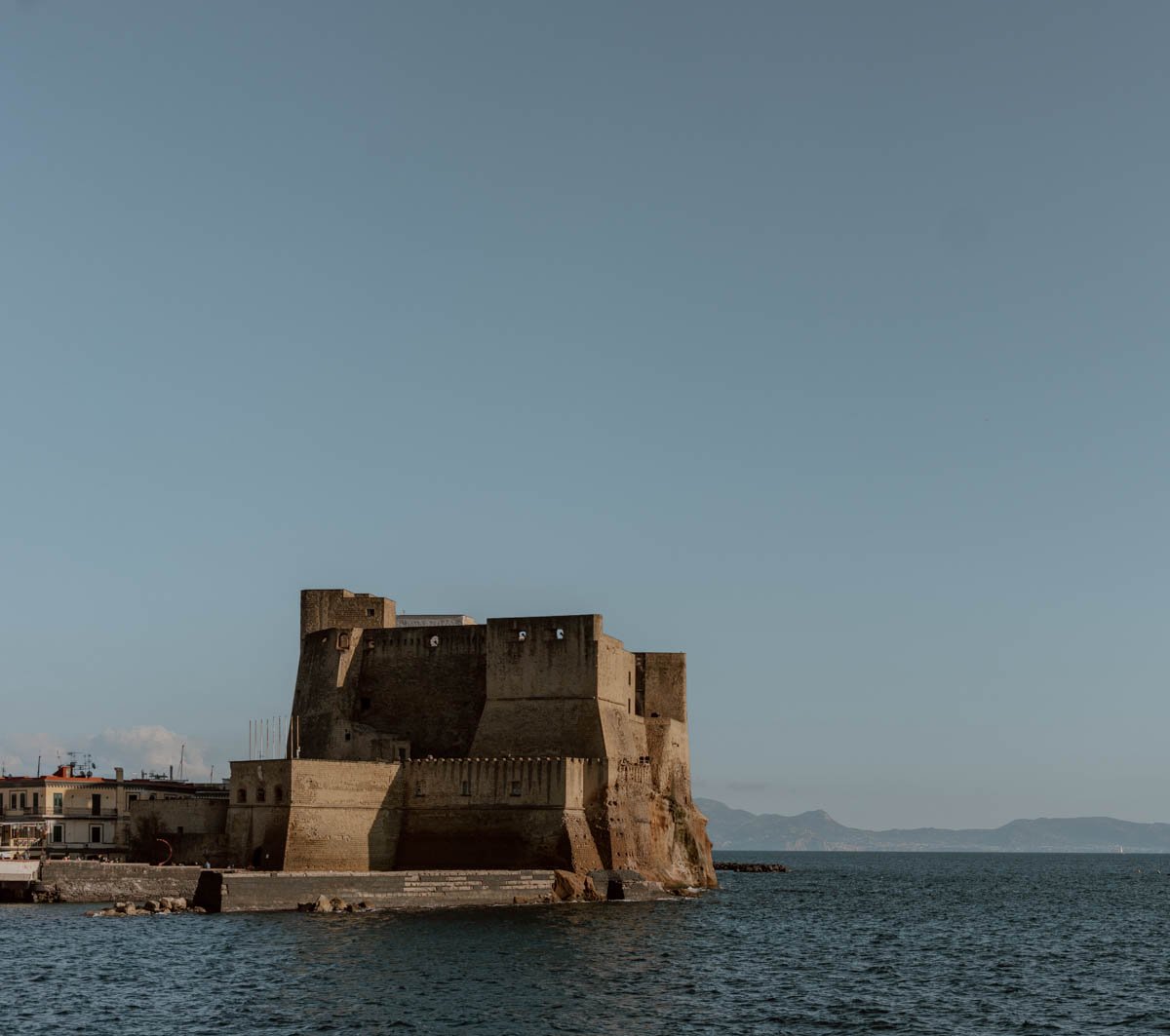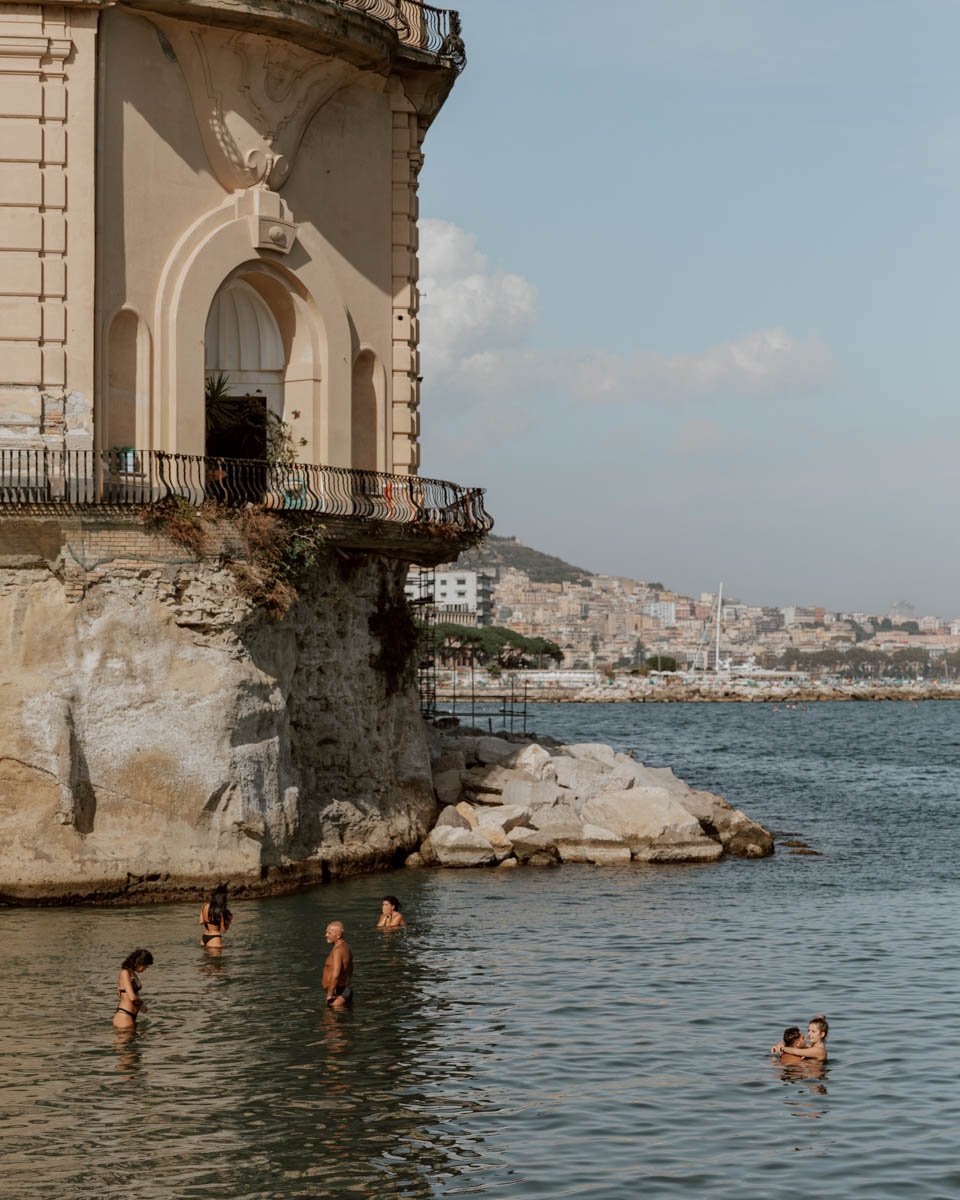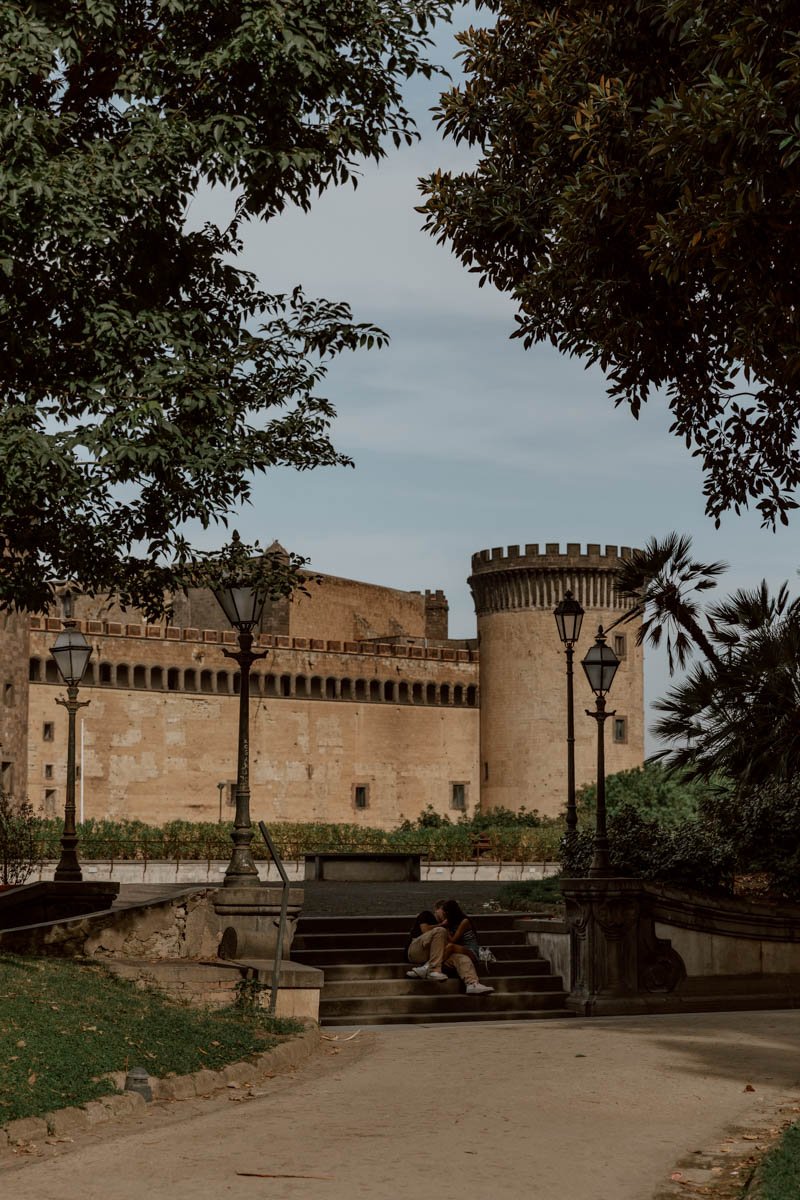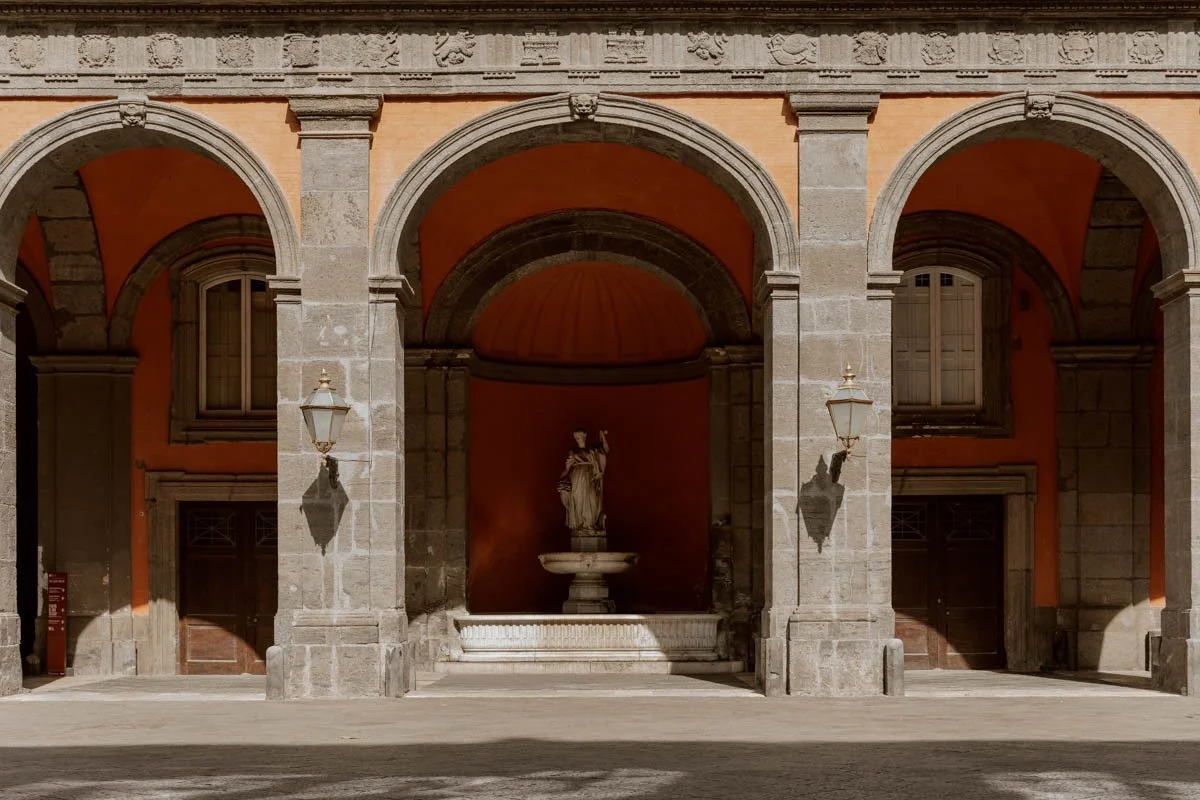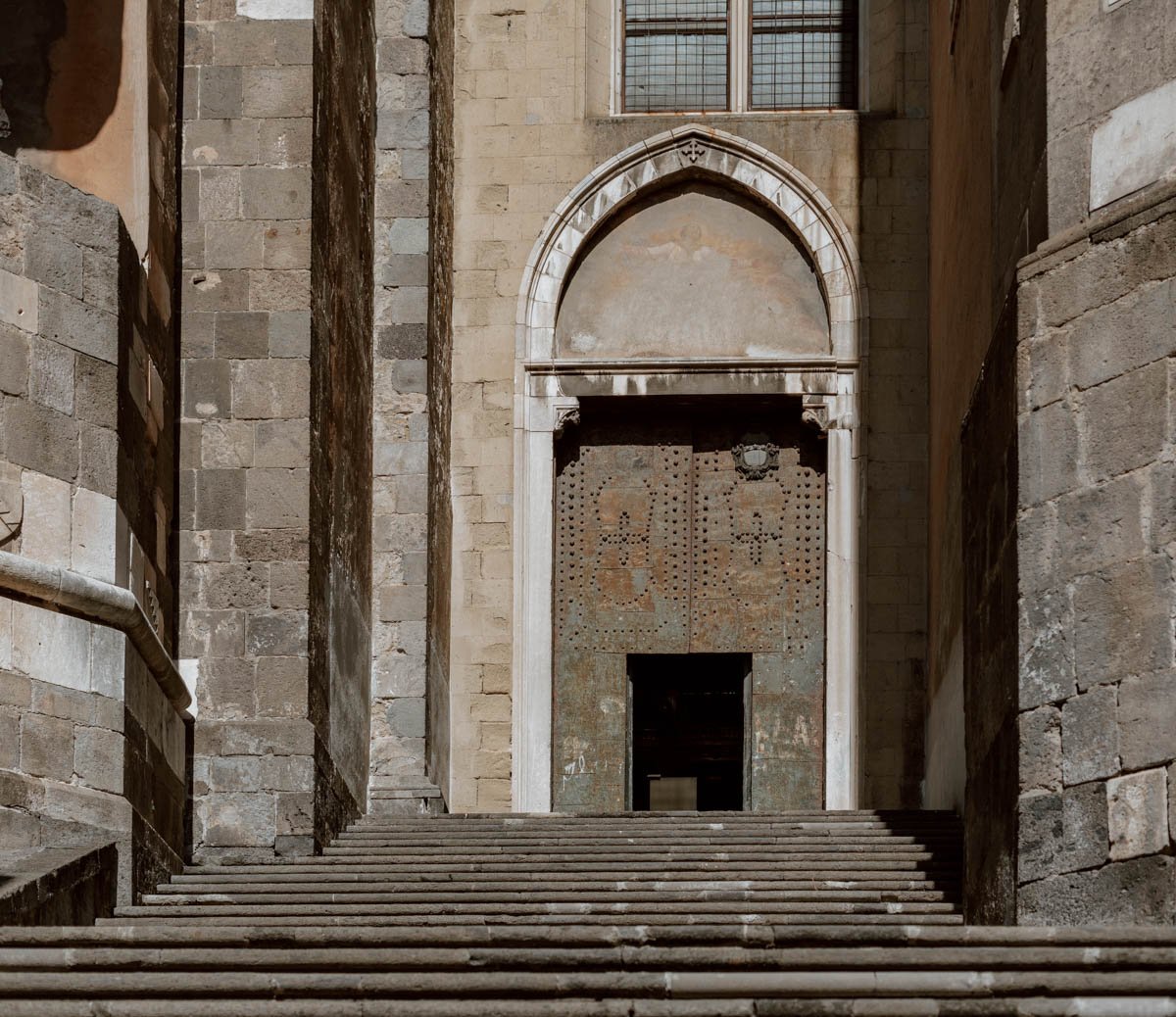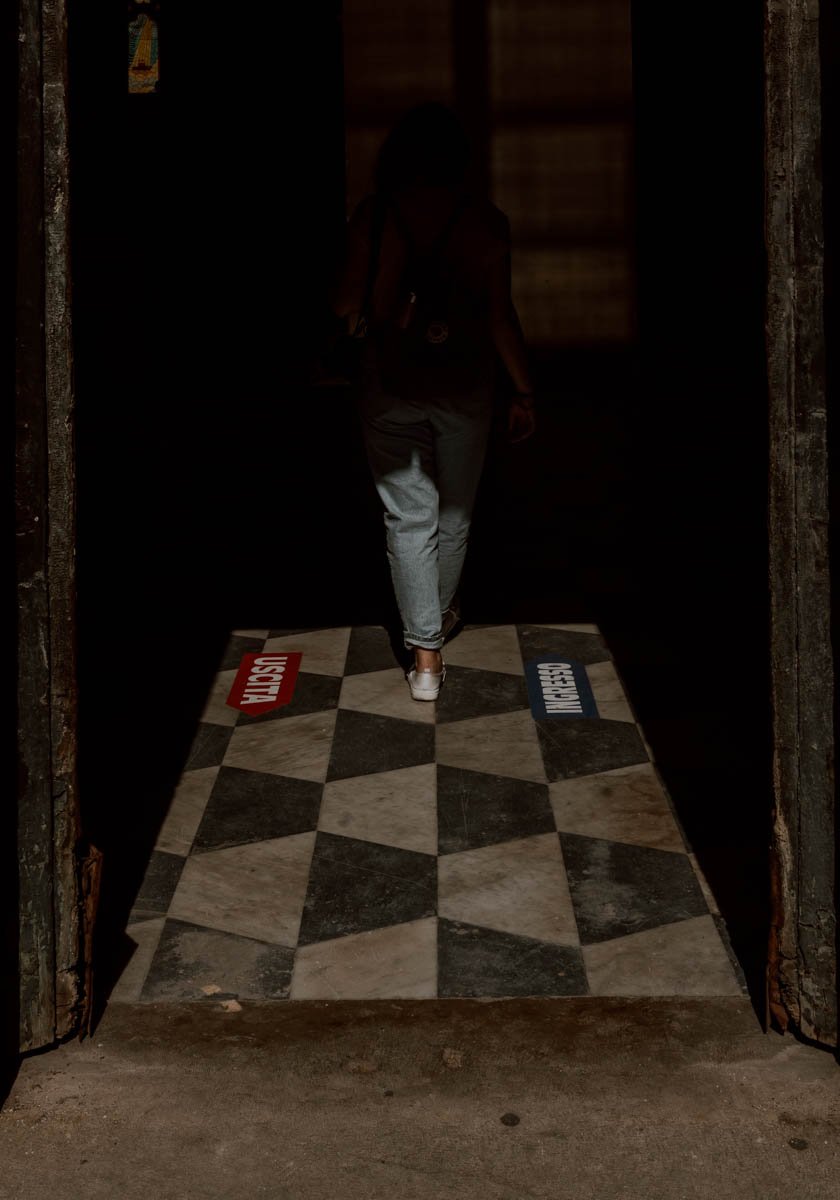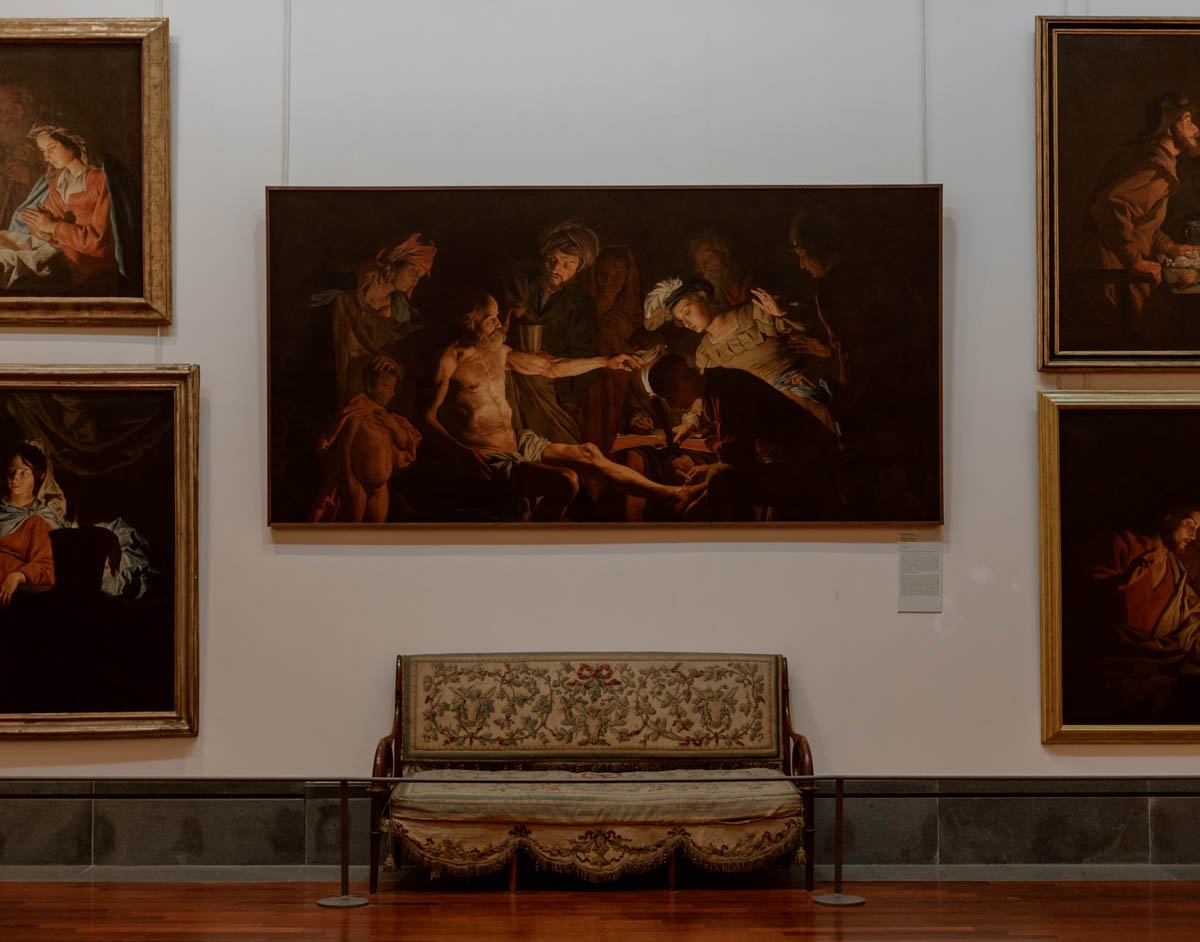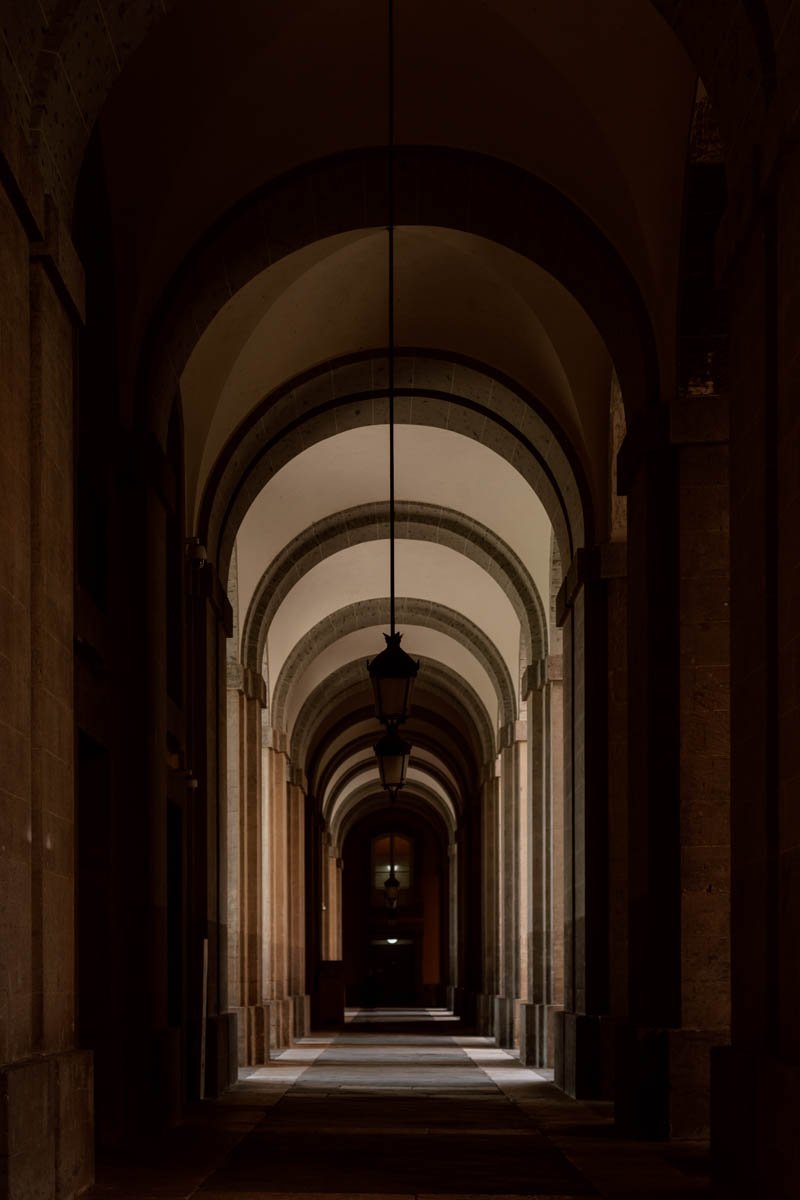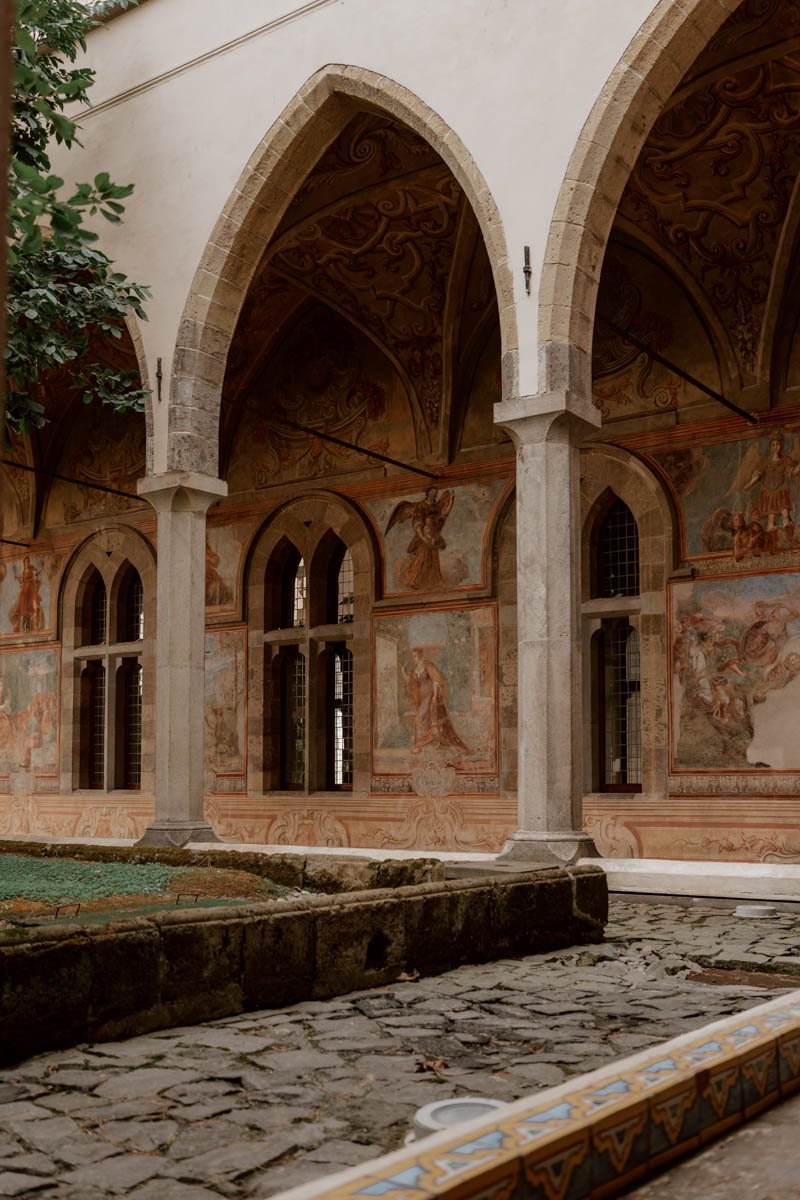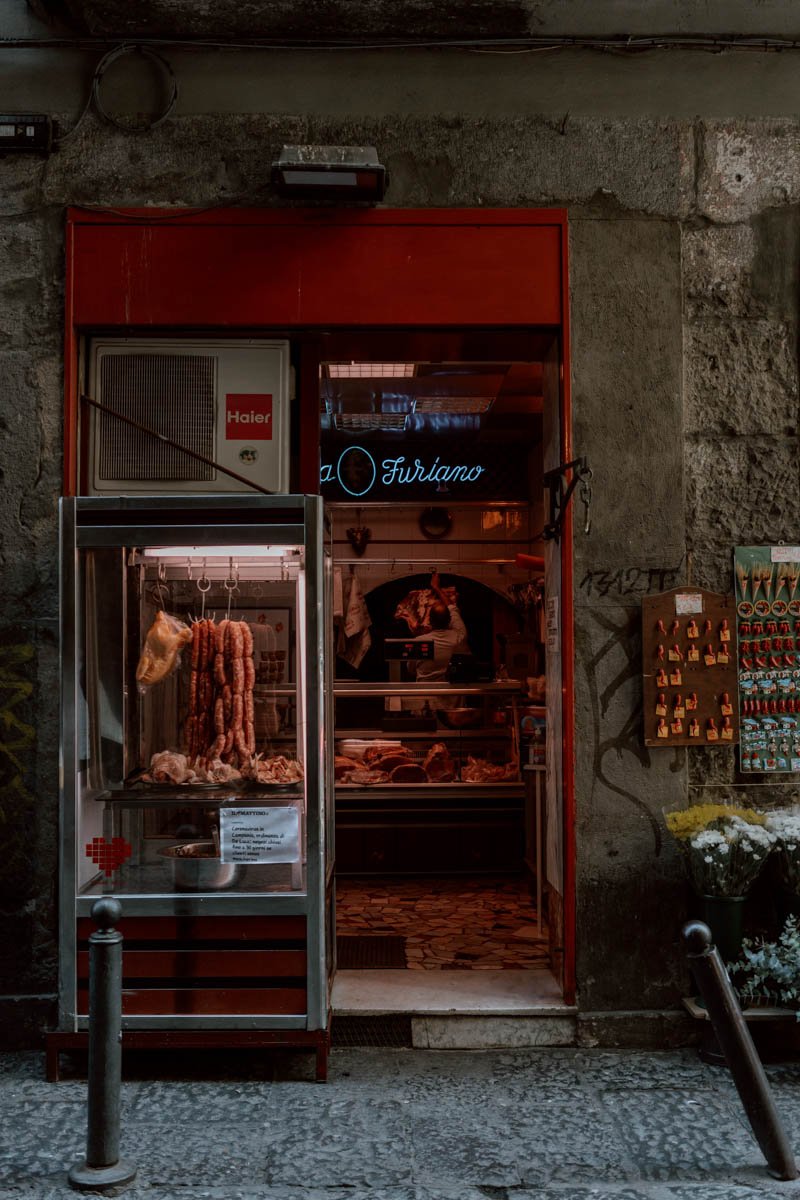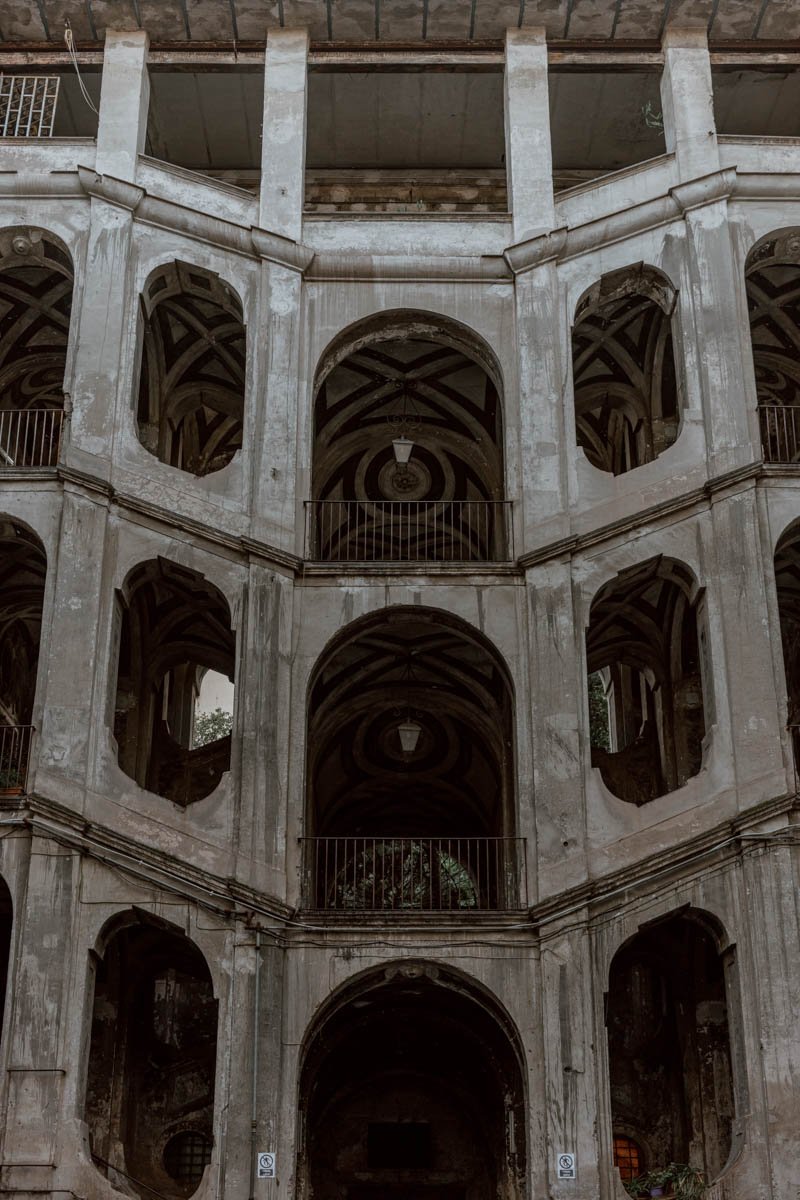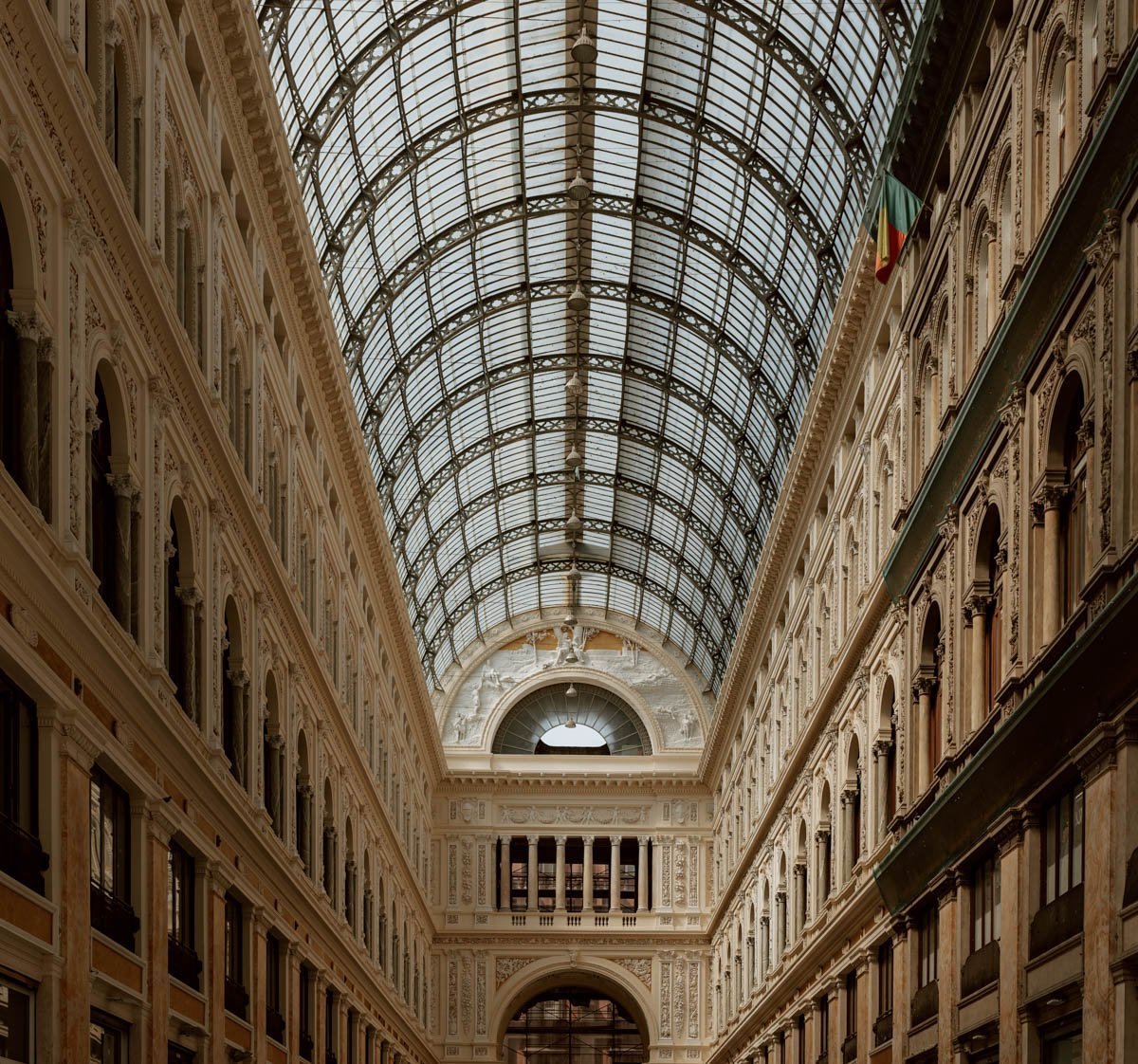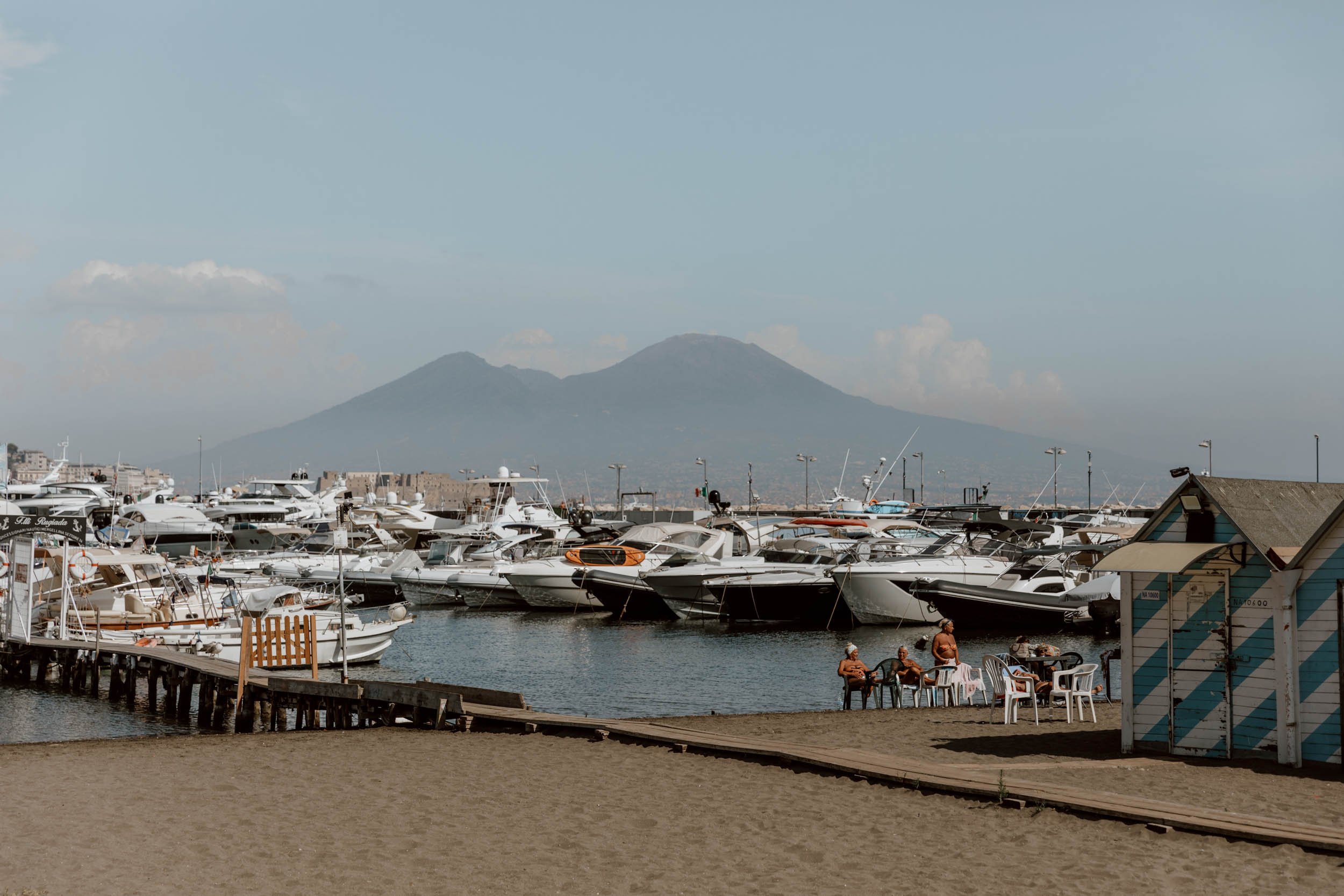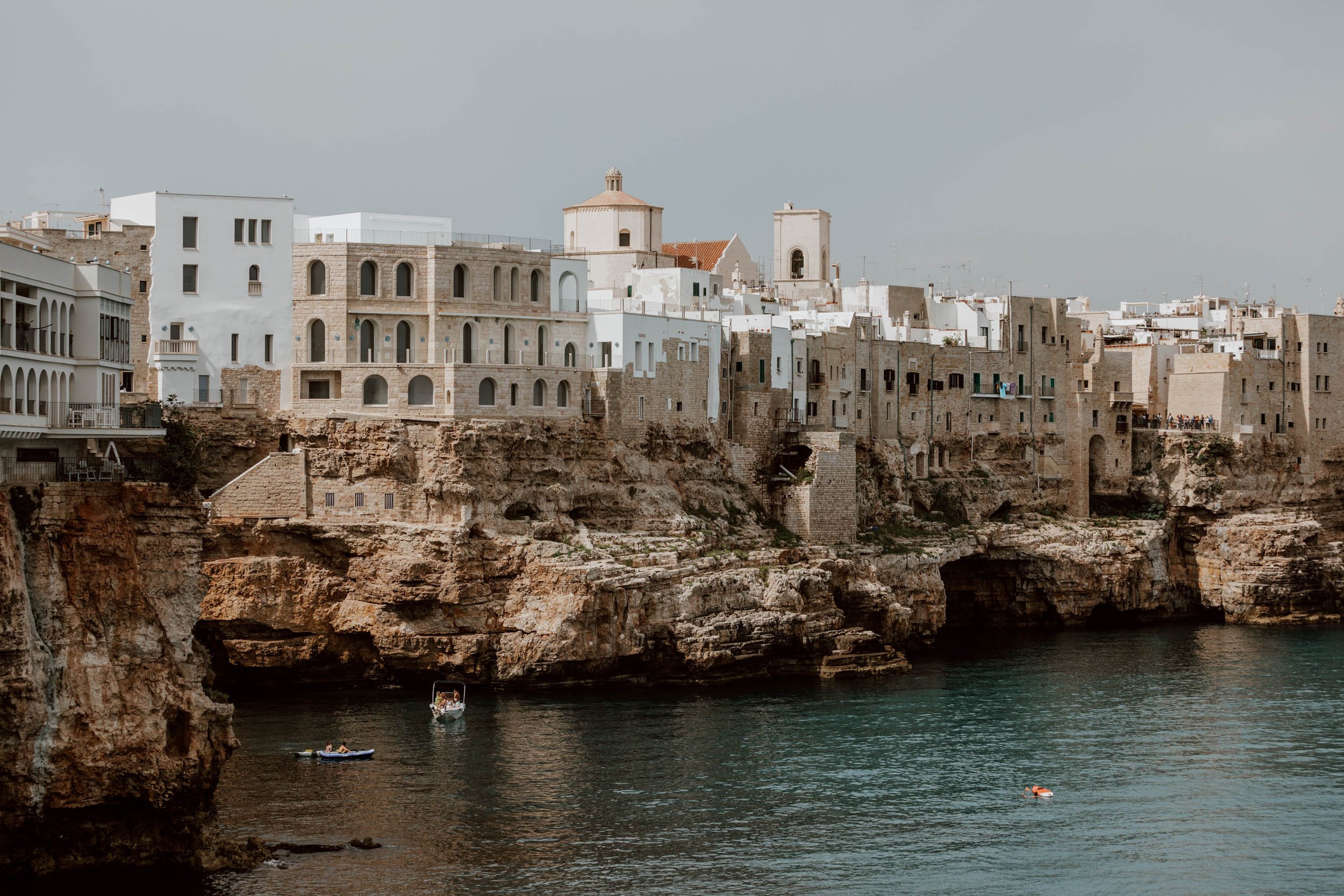Planning to visit Naples in Italy?
There’s far more to it than pizzas & Pompeii - our personal travel guide has got you covered.
"I now realise that I was talking about something I couldn't imagine.
Napoli has to be experienced - not imagined."
Luciano Spaletti
-
In 1984, a short Argentine with a mop of black curls and mischief in his dark brown eyes, arrived in Naples as a young man with a bad knee.
Over 75,000 people turned out to welcome him, some with tears in their eyes and hope in their hearts for a fallen angel who could perform miracles with his feet.
In less than a decade, from a city where two religions of Christianity and calcio live side-by-side, this controversial footballer would depart as a living god.
A deity whose image is found today on flags, windows, shirts, walls, billboards, bodies, bar shelves, apartment blocks, cardboard cut-outs, and street corner shrines on the level of saints, the Virgin Mary, and long lost loved ones (and sometimes even just a little above).
Diego Armando Maradona and Napoli, both occupying a space in sky blue between the sacred and the profane, were made for each other.
No other player was like Maradona, and nowhere else in Europe is quite like the rebellious southern Italian city of Naples.
It was a match made and maintained in heaven.
Chaotic, passionate, loud - someone is always screaming somewhere - a day in Naples’ narrow streets, rarely touched by sunlight, can sometimes feel like a week. Several of its palazzos are crumbling, there's graffiti almost everywhere, the traffic takes no prisoners, everyone smokes, the coffee is triple strength, and too many blackened Baroque masterpieces live in a state of run-down abandonment.
Many first-time visitors arrive expecting something else - more of the Italian elegance they'll find further north - and leave without realising that what makes Napoli so very very special is the fact that this place cannot be tamed.
It’s not a museum.
Like Diego, the flaws, the chaos, and the emotion are part of the charm; without them, there'd be no magic. This is why Neapolitans saw themselves in the little genius who led hem to two Serie A championships and a UEFA cup against all the odds. He was born for this place and team: embodying and reflecting their vices and virtues, their imperfections, the fact they may scrap and take shortcuts to overcome those who scorned them, cheat to win, and let you down as much as they could stir your soul.
To understand one, you have to understand the other.
After our first week in Naples (as non-Italians call it), we knew we could never hope to capture what makes it so beautifully unhomogenised and intoxicating. There is so much art, culture, and life, that it took us another week three years later to feel that we could even come close to doing it justice, and be in a position to write a proper Naples travel guide for you.
Because the truth is that some of you really will find it overwhelming and not at all what you want on a vacation. Too rundown, unkempt, or wild. A little unsettling in parts. Some of your friends may have already told you they hated everything (except the pizza) in Italy’s third-largest city so you'd be best to have just one night there before moving on somewhere more easily aligned with la dolce vita.
And with the Amalfi Coast so near, many do.
We think that would be shortsighted though, as this is one of our favourite cities in the world.
It's important not to overly romanticise Naples - to turn it into a living, breathing caricature, or be blind to the systemic issues which have blighted it for decades - but believe us when we tell you this city is home to so much to love and admire for the curious traveller willing to look beyond the grime and the reputation.
To help you do just that, we've shared all our personal recommendations on the very best things to do in Naples. From where to eat the best pizzas, finding masterpieces in surprising places, going underground into Roman ruins, the coolest neighbourhoods to hang out in, fantastic street markets, stellar viewpoints of Vesuvius, sunbathing spots, street art, food tours and experiences to book ahead, day trips, a photo stop of Soprano’s fans, and our secret places that the tour groups won't go, you'll have everything you need to head out and explore.
We've also included lots of advice to travel better, essential information to help you plan ahead, and tips to help you save money on tickets to the most popular places.
This is 19 Wonderful Things To Do in Naples - the Maradona city.
*we use Naples (the English name) and Napoli (the Italian) interchangeably in this post.
The Naples Essentials | UNMISSABLE FIRST-Time Experiences
/ Eat pizza every day - these are our 7 favourite Naples pizzerias
/ Get lost in the notorious Spanish Quarter
/ Tour one of the Naples underground tunnels
/ See the opera at Teatro San Carlo
/ Wander La Pignasecca street market + do a Naples food tour
/ Day trips to Pompeii and Mount Vesuvius
/ See two Caravaggio masterpieces at Pio Monte and Museo di Capodimonte
/ Embrace the chaos of the historic centre, or join a small-group walking tour for context
/ Take in the fantastic view from Sant’Elmo Castle
/ Marvel at some of the finest Greek and Roman treasures at the famous MANN
/ Hangout in the sunshine on the lungomare and eastern beaches
/ Gasp at the beauty of The Veiled Christ sculpture in Sansevero Church
/ Tick off churches, cloisters, and cocktails in Piazza Gesù Nuovo
/ Pack a copy of Elena Ferrante’s novel ‘My Brilliant Friend’
/ Find street art and characters in the Rione Sanità neighbouhood
/ Save a lot on tickets with the Naples Pass or a Campania Arte Card
Eat Pizza Every Day
Stuffing your face is a cultural activity that everyone can get behind, but the sad part is that, after Napoli, few pizzas will ever taste as good as they once did.
All told, we've eaten 20 pizzas in Napoli across the two trips because 1. we love pizza 2. the pizzas are that damn good here and 3. we take our work seriously, and wanted to know which ones to recommend to you (tough gig, but these are the sacrifices we make for Along Dusty Roads readers).
So, ditch any diet or conception of being 'carb-free'. You're not here to watch your weight or just 'have a slice or two'. Forget your mediocre crusts, stodgy bases and overly-cheesed up takeaway versions from Domino's, Pizza Hut, and Pizza Express, or a desperation yellow sticker deal at Tesco's when you're hungover. Shove your 'deep dish' up your arse and, hell, even put the cool new sourdough place that's just opened up down the road to the back of your mind.
Forget everything you know about pizza as you've once perceived it, as you are about to make a pilgrimage into the city of its creation and achieve something close to foodie nirvana for less than seven euro.
Any pizza you've had in the world is a spin-off of what was born in Napoli back in the 18th century as a cheap, quick meal, and it was carried to the rest of the world by Italian immigrants looking for a new life in Europe or across the Atlantic. One oft-told but sometimes disputed legend about pizza in the city goes back to 1889, and the creation of a pizza to honour the visiting Queen Margherita of Savoy; the ingredients or tomatoes, mozzarella, and basil represented the Italian flag and her name would forever be associated with the most classic of orders.
Simplicity, tradition, craft, and quality ingredients are key, and it’s the final two that elevate a pizza in Napoli beyond most you'll have outside of Italy (there's a whole different conversation to be had about why not every pizza in Italy is the same, but that's for another day). Culturally, it's important to the city's identity, and the art of making it is recognised by UNESCO as "intangible cultural heritage", and there's even an organisation responsible for promoting and protecting the true Neapolitan pizza in Italy and worldwide
In short, it's almost impossible to have a bad pizza in Naples.
The best part is that the food remains quick to make, affordable and unpretentious (although there are some rules you need to abide by when ordering one). There are over a thousand pizza restaurants in the city, and Neapoltian pizza's signature soft, thin base and chewy, charred crust is standard across all of them. At our favourite place, the base is so deliciously thin that it’s more like a crepe than what we've been served elsewhere. You can have it lunch or dinner, and the best and most famous restaurants will still charge less than €8 for the margherita of your life.
The only difficult choices you have to make therefore is how many you're going to have and which pizza restaurants to prioritise. Some have become so famous due to literary references, celebrity visitors, TV show features, or the quality of their pizzas, that you have to queue for a while to get a seat, the experience inside isn't what it once was, and they're the only restaurants in Italy where we've had a mandatory service charge (not just the coperto, which is something quite different).
We've shared our personal favourites and more essential advice to avoid two of the biggest 'faux-pas' tourists make when ordering and eating in this post: The Best Pizzas In Napoli
Travel Tip // If you want to go deeper into the art, tradition, and makers of Neapolitan pizza, then there are a handful of excellent highly-rated specialist tours available. We joined this Secrets of Pizza Tour to gain an understanding of the ingredients and love that goes into a pizza, but if you’d like to make your very own, consider this super popular class with a local pizzaiolo (that’s a proper pizza chef!)
Alternatively, if you’d prefer to sample a wide variety of Naples’ culinary delights, this 2.5 hour street food tour has literally thousands of excellent reviews and includes a visit to a limoncello factory, a gelato stop, traditional snacks and sweet treats such as taralli, babà and sfogliatelle, fresh mozzarella and sausages plus - of course - various types of pizza.
Get Lost In The Spanish Quarter
Once a no-go zone for most locals and all outsiders, the tightly-packed, high-sided streets of the Spanish Quarter have slowly emerged as a core part of the traveller's itinerary in Napoli.
Creeping up the slopes of San Martino, it was originally constructed as a military garrison for soldiers in the 16th century during the Spanish rule of Naples (hence the name), and since its inception the poor, densely populated neighbourhood garnered a reputation for crime and prostitution.
Neapolitans we know said they simply weren't allowed to go there growing up.
Today, the Quartieri Spagnoli offers a glimpse into the snapshot of the pace and rhythym of Neapolitan culture: busy, frenetic, loud, bustling, chaotic, jumbled, with scenes, set-ups, and characters that you would hardly believe.
Laundry hangs from balconies, streets and stalls are festooned with the colours and cut-outs of the football team, buckets on ropes transport goods up several storeys, a Vespa zips past you with a hairdryer exhaust, Ape trucks weave between crowds, women in bright, heavy make-up sell sky-blue counterfeit shirts, smoking men hawk perfumes and fruit beneath icons, murals, and death notices, and the cacophony of a normal day in Napoli provides the soundtrack.
In terms of atmosphere and aesthetic, it's close to what British people like us brought up on Scorcese films may think an Italian immigrant neighbourhood in 1950s New York would have felt, looked, and sounded like (Neapolitans formed a key part of those communities by the way, so there may be something to our comparison).
Between our two visits, it's clear that things are changing at pace in the Spanish Quarter, with a steady flow of tour groups, more tourist-facing restaurants and shops, and a stark rise in Airbnbs available in previously wholly residential and working-class apartment blocks. However, we think a clear and proud identity amongst residents will hopefully remain a sky-blue bulwark to the more invidious impact that creeping gentrification and homogenisation can have (though there are of course positives to this shift as well).
We suggest heading there in the late morning to wander around as life is starting to be lived, have your coffee somewhere local, and then take a chance on lunch or street food in a restaurant that catches your appetite. There’s not necessarily any big ‘sights’ to make a beeline for, and the enjoyment is in the art of observation and curiosity.
Via Emanuele de Deo (maps) is the busiest thoroughfare in the Spanish Quarter, and the streets in and around are where most of the action is found. Beyond that, you'll find yourself in quieter, more residential neighbourhoods; it's vital to remember that this remains a strong, thriving community and respect for those that live and work here is paramount.
Once a car park, then a personal project of devotion to the Argentine demi-god, the Maradona Mural (maps) was just a small bar with some memorabilia on our first visit. Now, spurred on by his untimely death in 2020 and Napoli's landmark third scudetto victory in 2023 (the first in 33 years), it's expanded to become a shrine. Arguably, it’s one of the busiest photo stops in the city and a place of pilgrimage for some.
Where | The Quartieri Spagnoli covers a deceivingly large area, with various entry + exit points from all sides. You can find it here on Google Maps, and it’s easy to nip in from any of the streets intersecting with Via Toledo (maps), the long shopping street.
If you’d like to know more of the neighbourhood’s history and meet locals, then consider joining this Spanish Quarter Walking Tour
Go Underground
There lies a city beneath the city.
One that was hollowed out to build the other, leaving a subterranean honeycomb labyrinth of tunnels, reservoirs, quarries, roadways, and burial chambers.
The Greeks started the process when creating their New City (Neapolis) in the 8th century BC, where we find not just the foundations, but also the etymological roots of Napoli. They dug for water wells and to mine tufo, a soft volcanic stone also known as Neapolitan yellow tuff, which built many castles and cathedrals here and across the Campania region.
And, as with much of southern Italy and the Mediterranean, where the Greeks once were, the Romans would surely follow; they increased and improved the network of aqueducts which this city relied upon for centuries for collecting, storing, and distributing freshwater to inhabitants, as well as sewage systems.
The soft volcanic stone continued to provide the building blocks for the construction and expansion of aboveground Naples, with the quarries extensively mined until the early 20th century.
It's thought that there are about 280 miles / 450 kms of underground tunnels in total and, following their unexpected usage as bomb shelters and community refuges during World War II (Napoli was the most bombed city in Italy), the cavities were left to be filled with rubbish and rusting Vespas.
Now though, going underground is one of the most popular things to do in Naples.
A guided tour is the only safe way to explore these subterranean tunnels, but with quite a few official and unofficial options and entrances, it can be a tad bewildering to understand which to prioritise or include in your Napoli itinerary - particularly as most of you summer visitors likely won't want to spend hours down there! That’s the reason we’ve put together a separate guide to ‘Undergound Naples’ to help you decide (published soon)
In short however, there are four main options for underground explorations in Naples:
Underground Naples | The most popular option in the city, also known as Napoli Sotterranea, this includes the Greek-Roman Aqueduct and the Roman Theatre. There are tours every hour, every day between 10am to 6pm but you’re best to buy a skip-the-line ticket to avoid the queues.
The Bourbon Tunnel | A distinctive alternative to the above that was commissioned by Ferdinand II of Bourbon, who created an escape route from the Royal Palace to military barracks in Via Morelli. It was used extensively during World War II, and there's a lot of fascinating history and items from that period. Opening times are limited and reservations are compulsory - buy your tickets here or here.
The Spanish Quarter Underground | We haven't done this one, but it's got excellent ratings and reviews. Given that it meets in a central location too, you could easily pair it up with your above ground wanderings in the Quarter or nearby. Find out more here.
The San Gennaro Catacombs | Located within the Rione Sanità neighbourhood, a visit to the San Gennaro Catacombs feels more like a human, archaeological and spiritual experience than the other undergrounds, with around 3,000 tombs recorded within it since modern excavations started in 1971.
They offer hourly tours Thursday to Tuesday, for which tickets can be booked in advance here.
Entry to the Bourbon Tunnel and San Gennaro Catacombs are included on the 3-day Naples Pass
Find more details + planning information in our guide to underground Naples (published soon)
Opera At Teatro San Carlo
Ever dreamt of a night at the opera? Well, in Italy you can make that a reality in one of the grandest settings in Europe.
Opera was of course born in the country, with many of its most famous singers and composers hailing from here. Naples, then part of the Bourbon kingdom, was a hotbed of culture and all the composers of the 18th and 19th centuries wanted their work to be performed in the city.
The reason is the Teatro di San Carlo.
Built in just eight months at the behest of King Charles III, it predates both the opera houses of Venice and Milan by a half century or so, with the opening night in November 1737 celebrated with a performance of Achilles in Sciro. Our guide told us it was the oldest theatre in the world, but other sources tell us that it's actually only the world's oldest continually active venue for opera in the world.
That's quite a big distinction, but not really important: it's stunning either way and a centuries old icon of Napoli.
Originally dressed in Bourbon blue and seating around 1,400, the sumptuous red and gold interiors that dress the main body and six tiers of boxes was a forced redesign. In 1816, at a ballet dress rehearsal the night before Valentine's Day, a fire ravaged Teatro San Carlo; the building was destroyed in less than an hour, with only the external walls unaffected.
Many of Europe's great theatres were also gutted by a blaze but, so important was San Carlo to the city, it was rebuilt in just nine months. The regional government funded more renovations and restorations in the 2000s.
We visited twice in one trip: first for a guided group tour and then for a spontaneously booked evening watching Madama Butterfly a couple of days later. It was our first time seeing a full opera performance (the previous occassion at the Arena di Verona amphitheatre was more of a 'greatest hits' sort of show), and we thought the memory and experience would justify the splurge.
Now, we absolutely don't think it's necessary to do both, but it's important to know that there are often very affordable tickets for performances.
If attending a show, we highly recommend trying to get a seat at the front of a box as the others will all have a partial or significantly restricted view of the stage. In terms of dress code, it’s best to dress as smart as possible, but formal attire is not required.
Tours | There are currently just two daily timeslots for the English-speaking tour - 11.30am and 2.30pm. These last just 30 minutes, and run concurrently in Italian.
Standard adult tickets are €9 and it's €7 for under 30s, and you can get a family ticket for €26.
There is no online option to purchase a ticket on the official website or aggregators but you can book your place on the tour of San Carlo Theatre via email. We bought tickets at the ticket window at the entrance about 10-minutes before the tour start time. Given its proximity to Piazza Plebiscito, Via Toledo, Galleria Umberto I, and Caffè Gambrinus (more on those later) you will likely pass by the theatre at least once, so consider booking a place on a tour for later in your stay.
You view upcoming performances and buy tickets on the theatre’s website.
Shop The Neapolitan Markets
Italy's approach to food is second-to-none, and once you get past the initial overwhelm in Napoli, you'll appreciate just how much of this is down to the maintenance of a refreshingly small-scale, independent, non-corporate approach.
So many shops and stalls and cafes and restaurants are still independent or family-owned, with many places still established to do just one thing very well - the fishmonger, the baker, the butcher, the fake football shirt maker - and large, national brand supermarkets or conglomerates are not that common.
Heading to one or two local markets is an enjoyable way to appreciate this model - and the communities it supports and sustains - as well as get up close and personal with some wonderful fresh produce.
From a cultural perspective, it's absolutely one of the best things to do in Naples.
These three are our favourites:
La Pignasecca | In the ideal setting to add on to your wanderings around the Spanish Quarter, this food market runs along the length of Via Pignasecca to Stazione Di Montesanto. It's open all day but is best to visit in the morning or you can arrive later in the day for a seafood lunch at Pescheria Azzurra. Find it here on Google Maps.
Mercato di Porta Nolana | It may be a little raucous or rough around the edges for first-timers, but this is Napoli down the core.
A street market with thrashing, squirming fish in buckets, men and women selling cigarettes - counterfeit or fallen of the back of a truck - from wooden trays, and flirtatious fishmongers shouting 'ciao bella'. This is close to Napoli Centrale train station, which can be a little intimidating to walk around at times, so do just be aware of that before scheduling it in.
Open from around 8am to 1-2pm, find it here on Google Maps.
Torreta Market | The only covered, indoors Napoli market on this list, it's a little out of the way so best to pair it with your walk along the lungomare or the beaches. In a more affluent part of the city, it's a lot calmer than the other two, and we wouldn't necessarily recommend going out of your way to visit it specifically. Lunch at Cibi Con Nonna Ann is a good idea if you make it, and don’t plan on eating pizza at 50 Kalo. Open from 9am until the late afternoon, find it here on Google Maps.
Hungry? The small-group Ultimate Naples Food Tour takes you to a market and produces, with 10 tastings letting you discover the city through its foods - find out more here.
This 2.5 hour food tour is also very popular, with excellent reviews.
Walk The Lungomare For A Soprano Surprise
"Tutto Passa"
The mantra tattooed on the chest of a man with skin the shade of mahogany and texture of leather is part of the excellent Samuel Alexander Gregg's portfolio. We discovered the British photographer's work in Napoli, his adopted city, early in our first trip and, for us, no one's portraits comes closer to capturing the spirit and the characters of this unique place.
You can find him on Instagram here, or view a Napoli series we love here. If you enjoy this style of photography, Ciropipoli (a Naples native) is another excellent Instagram account to follow.
(whilst we’re here, we might as well plug our own Instagram: @alongdustyroads)
Some of his most popular shots are of the groups of local men and women who spend most of their summer days bathed in oil sunbathing beneath the lungomare, perfectly embodying the attitude of 'everything passes' like living bronzed statues by the sea.
These characters and their bared bodies - some even use what we call the Paulie plate! - have become more well-known in the last few years on Instagram, and you will pass or join them as you walk along the lungomare.
The seafront promenade is home to the fanciest hotels in the city, a selection of sunbathing and swimming spots on the rock or smooth stone platforms, endless views of Vesuvius, restaurants, 'chalet' cafes, and a bewildering number of wedding photography shoots.
The fresher air and the space available offers a welcome respite from the crowded, traffic and tourist-clogged streets of the city centre, and affords the chance to stretch one's legs and see a different side to Napoli. On a sunny day, it's a nice alternative spot to have a drink or lunch/dinner too, whilst you can take a 10-minute boat ride for views for €5 per person.
We suggest you start off by heading down to the sea from the Royal Palace (maps), and then simply follow the water to the right up to at least Monumento ai Caduti del Mare and start of the public park (maps). If you go left instead, beyond the photogenic lido, it all bleeds into the port and becomes very industrial and cruise-ship heavy.
Carrying on beyond the public park takes you past the underwhelming Mappatella Beach, and you'll enjoy an excellent, lesser-visited viewpoint at Marina Molo Luise (maps) and see the lungomare change into more of a 'holiday' stretch with the various colourful kiosks and chalets. This also takes you into a wealthy part of Napoli, with grand art-deco buildings and a very different atmosphere and aesthetic to the historic centre.
Torretta Market and 50 Kalo are nearby.
Day Trips to Pompeii, Vesuvius, and Herculaneum
Italy's most important archaeological sites and amongst the world's most captivating historical heritage, both the Roman towns of Pompeii and Herculaneum are a popular and easy day trip from Napoli.
Indeed, visiting Pompeii is the primary reason for many travellers to even go to Napoli!
Buried under ash by the eruption of Mount Vesuvius in 79 AD, both were preserved in the most remarkable way for over 1,500 years until Pompeii's accidental rediscovery in 1748 sparked significant interest. Charles of Bourbon, the King of Naples, initiated the first official excavations in the mid-18th century, and there was a treasure trove of artefacts and humanity under the ash and pumice.
Talking about how they offer an incredible opportunity to 'step back in time to ancient Rome' is a cliché, but it vey much applies here for all generations of traveller.
Pompeii is by far and away the most famous of the two, significantly larger and seeing lots more tourists every day. You need a minimum of four to five hours for it, whereas the more intimate and better preserved Herculanum can be enjoyed in two hours.
Both UNESCO World Heritage sites are easily accessible from the city, making them perfect day trip destinations and one of the most popular activities in Naples.
Out of the two, we found Pompeii to be the most impressive and memorable, but you'll find as many people who prefer the more intimate experience and insight Herculaneum offers.
It's also very possible to add in a short hike up to the source of all this history, with a crater walk of Mount Vesuvius a sensible and enjoyable addition to kill two birds with one stone.
Plan | We've visited all three, and have dedicated guides to help you understand them and their history better, as well as choose and plan your own day trip(s):
- 17 Things To Know Before You Visit Pompeii
- How To Visit Pompeii from Naples
- Our Guide To Visiting Mount Vesuvius
Although it's logistically possible to visit Pompeii and Herculanum in a single day, we absolutely don't recommend attempting that independently. Those most passionate about the Romans or archaeology won't get enough time at either site, and it will be a long day overall.
If you're short on time and really do wish to combine them and guarantee you see the highlights of each, then it's best to take a tour like this excellent and highly-rated small group option.
However, most first-time visitors do not visit both the Roman sites on the same trip, so don't feel bad if you are only able to make it to one - which will be Pompeii for nearly all of you.
Instead, you should focus on the following combinations to enhance, complement and deepen your enjoyment of each individual site, rather than exhaust yourself or lose enthusiasm by trying to do too much in one go.
If you're based in Napoli and doing it independently, the best standalone + combination options are:
1/ Pompeii for a full-day
2/ Pompeii and Vesuvius in a single day - plan with this blog post
3/ A half-day at Herculaneum and the National Archaeology Museum (more on that later)
4/ Herculaneum and Vesuvius in a single day independently or with this tour
Alternatively, consider a combined Pompeii and Herculaneum tour that will take care of transport + logistics for you.
Visit The National Archaeology Museum of Naples
Home to many artefacts from Pompeii and Herculaneum, the Museo Archeologico Nazionale di Napoli (MANN) is one of Italy's most important museums and arguably the most important in the world for classical archaeology.
For some, it's as essential to understanding and appreciating the two ancient Roman towns as actually walking their streets (and not just because of the naughty 'Secret Cabinet' room).
It's in the museum, rather than within the ruins, where you'll encounter the best and most vibrant finds from the sites: mosaics, frescoes, busts, pottery, plates, jewellery, an array of detailed portrayals of erect penises, and a painting of a man having sex with a swan.
However MANN, as it's also known, is not just about them, with halls and cavernous rooms filled to the brim with a world-class collection of Greco-Roman antiquities, the most important of which is the Farnese Collection of classical sculptures and statues. Beyond the beauty and craft of several. thousand years ago, the sheer size of the colossal statues will blow your mind!
Housed across three floors within the massive 17th-century Palazzo degli Studi, a former military barracks and university, it can be a little difficult to navigate meaningfully and we actually felt the curation and layout of MANN was poor. With such a famous collection and reputation, it's probably quite easy to phone it in, but we thought it could do a lot more to structure and curate the collections, improve aspects of the visitor experience and flow, and link exhibits back to the archeological sites from which they were taken.
This is especially true when a full-price adult ticket costs €22*, and closures to certain exhibits for renovations or exhibition changes are quite common.
Top Tip // One infamous spot that you don’t want to miss is the ‘Secret Cabinet’ room, and not simply because of its illicit and controversial displays, or because we're immature, but because it actually makes one's understanding and connection with Ancient Rome so much more human and relatable than simply looking at another fresco, coin, or pot.
Due to the erotic and obscene nature of certain items, and the veil it removed for more prudish later cultures who idealised the Romans, it was closed off, censored, or only open to special people at various points in time. Since 2000 though, it has thankfully been kept open for the public to gasp, chortle, and tittle at.
Where & When | 19 Piazza Museo - here on Google Maps - a 15-30 minute walk from the historical centre depending on where you start. Alternatively, take the underground Line 1 to Museo or Line 2 to Cavour, then walk. The road outside is fast, busy and difficult to cross at times, whilst the building across often has lots of rough sleepers or drinkers.
MANN is open from 9am-7.30pm every day of the week, expect Tuesdays when it’s closed.
Tickets | We think €22 for the standard adult ticket is ludicrous! They try to get round that by making it a 'two-day ticket' but we know the reality is that the majority of visitors 1) do no know this in advance or 2) will not have the time / inclination to visit twice in two days.
They do not offer a one-day ticket, and if you wish to visit the Magna Graecia exhibit, you have to buy a separate ticket for €1.50.
MANN tickets are however much cheaper for 18-25 year olds and disabled travellers, and everyone gets free entry on the first Sunday of the month.
You can buy tickets here or here (this second option has free cancellation) to skip the queue, or get them at the ticket office upon arrival.
Alternatively, if you buy the Naples Pass, it will significantly reduce the cost of the standalone full-price MANN ticket as well as give entry to Pompeii and the Royal Palace. Find out more or buy it here.
Further information | We’ve shared more information on which is the best card to buy, the free entry days, and more advice to help you make the most out of your visit, in this post: 7 Things To Know Before Visiting The National Archaeology Museum of Naples (published soon)
For travellers who are more interested in seeing the highlights of the collections and don’t have a lot of time in Napoli, you should consider joining this highly-rated guided tour of the museum
See The Caravaggio AT Pio Monte della Misericordia
Keep your eyes open in Naples and you'll find there are far more palazzos (palaces) and grand buildings hiding in plain sight, or behind those closed-off tall stone archways.
The condition of some is truly perplexing - in a sclerotic state of half-abandonment or dilapidation - whilst others have lost their sense of place as the wild-haired city grew up around them, engulfing them without regard for previous prestige or privilege.
If it wasn't for a painting hanging inside for over four centuries, Pio Monte della Misericordia is perhaps somewhere that you would simply walk on by.
However, the small octagonal chapel within the palace is home to what some consider the most important painting in Naples.
With a reputation as a violent, arrogant rogue, Caravaggio was a controversial man for his time. His art though - prioritising raw realism and perfecting the chiaroscuro technique - was revolutionary, and he is rightly held as one of the world's greatest painters.
He also happens to be the favourite artist of one half of Along Dusty Roads!
Wanted for murder in the Papal States, he fled to the Spanish-led Kingdom of Naples in October 1606, and picked up a commission for 400 ducats; at the time, this was the highest fee he'd ever commanded so perhaps crime does pay!?
This commission came from the young, noble founders of a four-year old Christian organisation committed helping those in need with the 'Seven Works of Mercy', including feeding the hungry, clothing the naked, and caring for the sick.
Caravaggio was hired to encapsulate these guiding charitable acts, and give their new church the most prestigious alterpiece in Naples.
Quite remarkably, over four centuries later, the philanthropic organisation still exists and Caravaggio's painting still hangs in the small, intimate church.
Seeing a work by Caravaggio hanging in the building for which it was painted - rather than a museum or gallery - was a massive travel highlight for us, and we spent an hour poring over every stroke.
It's a typically raw, dark and chaotic scene, where any sense of charity of kindness seems lost to the shadows of a street corner more reminiscent of riot escape. Caravaggio's signature chiaroscuro is in full force, with the wonderfully painted light pouring in from the top left on a diagonal, illuminating grimacing faces and buttressed by the internal light source of the flame torch.
There are so many details and elements amongst the darkness, and we don't to give too many 'spoilers' here: it's much more rewarding for you to dig them out as you contemplate the work in person.
However, we do need to give a bit of context to the woman you'll see on the right of the painting, clearly breastfeeding an elderly man. To make it even more ick, that's actually meant to be a father and a daughter (Cimon and Pero) with the young woman fulfilling two 'merciful' duties of giving 'water to the thirsty' and 'visiting prisoners'.
Big ick.
Although Carvaggio's painting is the main reason to visit, Pio Monte della Misericordia also has several other works of Renaissance and Baroque art, as well as some contemporary pieces upstairs.
Where & When | You will find the entrance and ticket office on 253 Via dei Tribunali in the historical centre of Naples, just round from the Cathedral. Find it here on Google Maps.
The opening hours are10am to 6pm Monday to Saturday, 9am-2.30pm on Sundays. Last entry is 30 minutes before closing time.
Those of you with a keener interest in art or the artist may wish to join this Caravaggio in Naples guided tour.
Tickets | It's €10 for a standard adult ticket, €8 for those under 25, and free to disabled travellers. Family tickets are available for €20.
That is quite a lot of money to effectively see a single painting. However, ticket sales for Pio Monte della Misericordia continue to finance social activities and the organisation's charitable causes and for us it was absolutely worth it to see this Caravaggio in this setting, but we do appreciate that it may be too much of a stretch if you're not as passionate, or you're already spending a lot on other things to do in Naples.
The best place to buy them in advance is on the official website here, but there is an admin fee of €1.50 per ticket. Alternatively, there is also a small ticket office opposite the entrance to Pio Monte and across from the well-known street art piece by Roxy in the Box of ‘San Gennaro and Caravaggio’.
As with many of our favourite things to do in Naples, Pio Monte della Misericordia operates on a timeslot system.
The Caravaggio in Naples guided tour includes your entry ticket.
Know | After first falling for his work in Malta, we're always on the look out to see more when we're in Italy (and there are two others waiting for you in Naples…). If you'd like to learn more about Caravaggio's life and works, there are two books we own and can recommend: Andrew Graham-Dixon’s is the most accessible and enjoyable read, and the other is a quite serious tome by Catherine Puglisi.
seek out the many Castles Of Naples
It's testament to how much this city has going for it that, despite having SEVEN bloody castles, there are very few people who arrive here to specifically visit one or even know about them in advance.
Contrast that to Edinburgh or Prague, for example, and you get the gist.
Now, we don't think you should in any way plan to visit all of Napoli's castles (some aren't possible, some aren't worth it) but there are three which we’d consider adding to that likely ever-increasing to do list: Castel San't’Elmo, Castel Nuovo and Castel dell’Ovo.
Castel Sant’Elmo
This fortress offers unparalleled panoramic views over the city and out onto the Bay of Naples, Vesuvius, and even the islands of Ischia and Capri.
Built in the 14th century atop Vomero Hill under the rule of Charles II of Anjou, the defensive, militaristic purpose is clear from its strategic position and squat, imposing star-shaped design. Taken over by the people during the revolution of 1799, later becoming a prison.
It offers the best viewpoints of Naples, and also houses the worthwhile contemporary art focussed Novecento Museum and various temporary exhibitions.
We recommend spending a good amount of time up on the ramparts and large rooftop area, with a highlight being the perspective it gives on the Spaccnapoli, the main artery cutting through the city centre.
Where | It's a decent walk up from the historical centre or lungomare, so you may prefer to do as we did and take the funicular from Corso Vittoria Emmanule (maps) to Morghen station, and walk the short distance from there. The Vomero neighbourhood is also quite different to other areas of Napoli, so by all means have a wee wander before/after if you're looking to see a different side to the city.
Find Castel Sant’Elmo here on Google Maps
When | The castle is open every day from 8.30am-7pm, but the attached museum is 9.30am-5pm and closed Tuesdays.
Tickets | Standard tickets are €5, concessions are €2, and this covers both the castle and Museo del Novecento. You can buy tickets online here but it's easier just to get them at the entrance.
The castle is also included on the five-day Naples Pass package.
Castel Nuovo
We actually think this prestigious medieval castle, the main royal residence for centuries, is quite missable in comparison to the other two, especially if you've not got long in Napoli.
However, the fault for that lies primarily with its incongruous setting by the busy, permanently under construction road, cruise ship port and the poorly designed Piazza Municipio. Such a hodge-podge of modernity undermines the visitor experience, and this section of Napoli always feels like a no man's land of tourists walking and traffic.
Commonly referred to as Maschio Angioino, the 'New Castle' was completed in1281(yes, that long ago) after the loss of Sicily meant the House of Anjou's Kingdom had to transfer its capital from Palermo to Naples. Due to this, this Castel Nuovo has a lot of historical importance as seat of the kings of Naples, Aragon and Spain until 1815 (remember that Italy only unified in 1861).
Highlights include the Sala dei Baroni and its stunning frescoes, whist the City Museum is also inside.
Where + When | Find it here on Google Maps. Open Monday to Saturday from 8.30am to 6.30pm (last entry at 5pm), closed Sundays but free access still possible to certain areas.
Tickets | It's €6 for standard tickets, free to visitors under 18 years. Numbers are limited to 60 people at each designated timeslot. You can queue to get them in person, or prebook your ticket and timeslot via link on the official website here
Castel dell’Ovo
The legend goes that Roman poet Virgil placed a magical egg within the foundations of the castle, claiming that as long as the egg remained unbroken, the city would be protected from disaster.
That’s why it’s called 'The Castle of The Egg’.
Located on the Megaride islet, the oldest castle in Napoli is rather dimunitive but an immensely photogenic part of the city’s lungomare. It’s passed between the various civilisations that have claimed the Bay as a stronghold, and over the centuries, served as a royal residence, a military stronghold, and even a monastery.
From within, it offers a serene environment to explore at an unhurried pace, with several viewpoints back on the city and over the water, with fishing boats often passing by.
Unfortunately, since our first visit, the castle now seems to dip in and out of temporary closures and offers more limited access for visitors.
Previously you could get in for free with pre-booked online reservations on the hour, but it then changed to free access only to the terraces in order to enjoy and photograph the views. To visit the full interior, you need to join a guided tour for €10.
At time of writing though (late 2023), it's closed to the public for restoration works, so do let us know in the comments when this changes; the official website will be best for up-to-date info.
Where | Find it here on Google Maps. Pair your visit or stop here with your walk along the seafront, which extends for a good distance to the best beaches in Naples.
Top Tip // Just across Via Partenope is the fancy Hotel Excelsior, where Tony Christopher and Pauli stayed in the Sopranos' excellent Napoli episode. It's our favourite TV show, so we naturally had to get a pic outside - commdantori!
The Beaches of Napoli
Over in 23 Things To Know Before You Visit Naples (published soon), we told you not to come to this particular Mediterranean city in search of beach time or resorts.
There are however a couple of decent local's beaches to know about in the relatively affluent, off-the-beaten-track east of the city.
They're separated by the Palazzo Donn'Anna, a grand baroque building that was never finished and stood lonely and crumbling on the shore for centuries.
Once grand and beautiful, but in a haunted state of disrepair and neglect, the palazzo wouldn't really exist like this in many other of Europe's Grand Tour cities, and it's very, very Naples.
(there’s a wonderful quote by writer Raffaele La Capria which conveys so much of how the state and standing of the Palazzo Donn'Anna is shorthand for how hundreds of grand old buildings in the historical centre and beyond contrast with those in other great European cities in Europe)
Anyway, back to the beaches.
The front of Palazzo Donn'Anna, unfortunately covered in scaffolding and tarpaulin when we passed by, overlooks the left-side Bagno Elena beach (maps), whilst the back of it looks out over Spiaggia delle Monache (maps).
The former has a couple of lidos as well as a large free beach area, whilst the latter has the photogenic green and white umbrellas of Bagno Sirena lido (maps), as well as ample space on rocks and an area of free beach. If looking for a full beach day, we'd pick Bagno Sirena as it's got a better swimming area and we like the rocks, but there's no huge difference between the two.
Note that whilst it's free to access both beaches and enjoy the free, public sections, lidos in Italy charge for access, which includes sunbeds and an umbrella for the day. If it's your first time in Italy and you plan on visiting more of the coast, then you need to know how ubiquitous lidos are and the pros/cons of how they operate - read this short explainer to lidos in Italy.
The Napoli lidos have different rates depending upon time of year, but expect to pay €32 for two sunbeds and an umbrella in high summer season.
Know | The access gate down to Spiaggia delle Monache is located along Via Posillipo, the main road that traces the coast, but it’s not in a terribly obvious location.
To find it, face away from the sea and on the right hand side of the road look for a black gate with brown sign that's covered in stickers (here on Google Maps) - that's where you need to go down a set of stairs and under an arch to arrive at the beach club. Continue down the wooden walkway between the chairs, lido and restaurant, and you'll emerge out on to the free beach.
Please note that these stairs are only open 9am to 5pm, and whilst that may be different in the middle of summer, we can’t be certain.
Travel Tip // If you're not really here to sunbathe, but would like to check out the Palazzo exterior and the beaches, then we suggest heading into Moccia cafe (maps) and making a beeline to their little outdoors balcony for a coffee or spritz with views of the beach, the water, and Mount Vesuvius brooding in the background.
A Ferry To The Phlegraean Islands & Capri
You may never have heard of the Phlegraean Islands, or have a clue how to pronounce it, but you'll almost certainly want to visit some of them.
Comprised of Ischia, Procida, Vivara, and Nisida, they're off the coast of Naples and easily reached by the regular daily ferries from the Porto di Napoli.
The largest of the four - Ischia - is a popular destination in its own right, with several good beaches, thermal resorts, and botanical gardens.
Colourful little Procida is however the place we found to be really quite special.
It's possible to visit either of the islands as a day trip from Naples - with Procida our recommendation if you're visiting just one - but we opted to spend a week across the two in order to get to know them as well as possible.
Note that the more famous island of Capri is often erroneously included in this archipelago, but it's technically not part of the The Phlegraean four. However, it's also easily reached by the regular ferries departing from Napoli, and is very popular with tourists looking for a more chic, expensive version of southern Italy.
The Porto di Napoli - the main ferry terminal in Naples - can be found here on Google Maps.
Plan | We'll be sharing more in our soon-to-be-published Procida and Ischia guides, as well everything you need to head to Capri and other popular day trips in the 7 Best Day Trips from Naples.
From Naples, note that one of the most popular options is join a day trip tour of the Amalfi Coast
Gasp At Sansevero Chapel
Stendhal syndrome is a psychological affliction linked with Florence, where exposure to so many art works of great beauty puts an individual into a state of ecstasy, hallucination, or fainting.
Read more about it here.
We think there's a flipside too, where a traveller develops a state of ennui when they're able to witness so many great works of art, in such a short window, that they simply cannot fully appreciate each piece.
Stepping into the Sansevero Chapel is an anecdote to latter, but a likely cause of the former due to the presence of two or three masterpieces.
An aritorcratic family's chapel was built where an image of the Madonna appeared to a prisoner in the 1590s, but it was the vision and changes introduced by Raimondo di Sangro, the seventh Prince of Sansevero, that created the baroque religious and artistic treasure chest that has enthralled visitors to Naples since the 18th century.
The Prince was, by all accounts and evidence, a details-oriented genius who poured much of his time, creativity, and fortune into the Sansevero project. A temple rich in symbolism, he personally designed much of the layout and supervised the works, as well as commissioning the marble sculptures that will have such a spellbinding impact on you.
We have simply no idea how the human hand and chisels can turn stone into air.
Giuseppe Sanmartino's Veiled Christ (Cristo Velato), laid to rest in the centre of the main hall, is the centrepiece of the Chapel. It is widely regarded as one of the greatest sculptures of all time, and worth the price of entry alone.
However, it is the female figure of Modesty, above and to the left of him, which had us both totally transfixed.
Do not miss them.
Where & When | In the historic centre of Naples, find Sansevero Chapel here on Google Maps.
Open from 9am to 7pm every day except Tuesday, with the last entry slot 30 minutes before closing.
Tickets | Visits to Sansevero Chapel must be booked in advance, and daily numbers are limited.
You are required to choose a specific entry timeslot when purchasing your ticket, and slots do sell out. Therefore, to avoid disappointment, we recommend buying your Sansevero ticket online at least 24 hours in advance of the day you wish to visit (online tickets are made available two months in advance of dates).
You can buy tickets on the official website here.
An alternative option is to buy them in person at the small ticket office by the entrance, but do note that you are by no means guaranteed a spot in the next time slot or that day, so factor that into your Naples itinerary planning.
A standard adult ticket is €10, or it's €7 for people aged 10-25 and disabled visitors. Children up to 9 years old enjoy free entry. A multi-lingual 25-minute audioguide is also available for €3.50, but we didn't take up that option.
There are also two very highly-rated walking tours, which both include your ticket and time at The Veiled Christ: this one and this one.
Plan | No phones, cameras, or video equipment is permitted inside Sansevero.
This is strictly enforced by one or two people in the small chapel, and it was a delight to see them tell off a couple of visitors trying to circumvent it.
Sincerely, this move makes a huge difference to the experience and appreciation of the art, and we encourage you all to respect it and enjoy what it represents in this fast-paced, ever-connected world of distractions. We had a small canvas bag to put away our phones and cameras, and we suggest that this isn't a place to arrive with anything larger than a small rucksack.
Travel Tip // For the best experience, you want to book the first slot of the day or the last few slots. Arriving toward the end of the day is definitely better, as the main room will empty out the closer it gets to closing time. We spent 45-minutes here, being one of the last three people to leave, and think you'll need at least thirty minutes inside.
We recommend you arrive and join the queue 5-10 minutes before your timeslot - you can grab a decent spritz from Caffè Svelato nearby. It's also a good idea to switch your phone off or onto silent mode.
The Royal Palace & Piazza del Plebiscito
Between the Spanish Quarter and the sea, the Palazzo Reale dominates.
Commissioned in the 17th century, it was one of the principal residences for the House of Bourbon royals, who ruled the Kingdom of Naples from 1734-1806 and again when it was under the unified Kingdom of the Two Sicilies from 1816-1861.
If you want to get a sense of how central the city of Naples was in European power games and plots, and the pomp and spectacle of the court, this is the place to go.
Salmon pink and stone, its size and scale is masked from the outside, and one needs to explore its rooms, courtyards, and hanging gardens by the sea to get a sense of it. Within, you can visit the Biblioteca Nazionale di Napoli - which has 2000 papyri found at Herculaneum - the Palatine Chapel, and the collections of the Museo del Palazzo Reale spread across the palace's Royal Apartments.
There's also the new The Galleria del Tempo, detailing the history of the whole city.
However, if you're not too interested in this period of history or prioritising elsewhere, we suggest at least walking through the central courtyard area to the peaceful 'Romantic gardens' (which deserve their name and are a good spot to seek solace to if you're finding the traffic or vibe of the city a little overwhelming, providing you can put up with all the snogging).
To really get a perspective on the scale and splendour of the Royal Palace’s facade, it's necessary to go quite a few steps backward into Piazza del Plebiscito. However, don't be surprised if there's something blocking your way between the two statues - the piazza is regularly used for open-air concerts and events, and there was a stage being erected on our first visit, and not long dismantled on our first.
The vast and pedesitrainsed Piazza del Plebiscito is perhaps Napoli in microcosm. Grand and European in design and architecture, the closer one gets to its buildings, the more abandoned it becomes, with graffiti and the stench of various stale liquids.
It's sort of bewildering that it's in that state, rather than a centrepiece, but at least it's better than what was there until 1994 when it was, quite unbelievably, a car park.
Where & When | You can find the Royal Palace here on Google Maps, just around the corner from Teatro di San Carlo.
The Royal Place is open 9am-8pm, every day except Wednesday. The various gardens and the Galleria del Tempo have varying opening times, so you're best to find these on the official Palazzo Reale website
Tickets | Entry is €10 full-price, and €2 for EU citizens aged 18-25. You can buy them at the ticket office at the entrance from Piazza del Plebiscito, or in advance via the official website.
On the first Sunday of each month, access is free for all, but you have to queue for the ticket in person on the day. It's included on the 1-day Naples Pass.
Top Tip // Just before you go to the palace or the piazza, pop in to Gran Caffè Gambrinus (maps). Opened in 1860, it quickly became one of Europe's most notable literary salons and a hub of writers, thinkers, and artists. Today, it's very much a tourist hotspot, but still has plenty locals and Italians frequenting it. Rather than sitting at the outdoors tables by the busy road, we suggest popping in to have a rapid coffee standing al banco, watching the smart waiters conduct traffic.
Blood & Treasures in Naples Cathedral
As with every town and city in Italy, you could fill your day by visiting any number of churches. The most important here though is undoubtedly Naples Cathedral, also known as the Cathedral di Santa Maria Assunta or Cattedrale di San Gennaro.
A fusion of Gothic and Baroque styles, its exterior is rather plain in comparison to the better-known Duomos of Florence, Siena, and Milan; the interior is however breathtaking.
The Cathedral is also home to the city's most revered religious relics: the bones and blood of San Gennaro, Naples' patron saint. Three times a year, the 'miracle of the liquefaction' takes place, whereby thousands arrive to witness his blood transform from solid state to liquid.
The phenomenon and ceremony has been taking place here for centuries and, sceptic or not, both it and San Gennaro are strongly embedded in the city's traditions, faith, and culture - locals often pray to his bust placed on the high altar for charity and protection.
On the 19th September, there's also the annual Feast of San Gennaro (which also takes place in New York's Italy), with parades, religious processions and music across the city.
Within the Cathedral, the most awe-inspiring sight for us was the central dome in the Cappella di San Gennaro. Its celestial scenes were primarily painted by Domenichino, who received so many threats after getting the most prestigious job going that he fled Naples, only returning as his wife and daughter had been taken kidnapped!
His premature death several years later meant Giovanni Lanfranco completed the dome.
Where + When | In the historic centre, you can find the Naples Cathedral here on Google Maps
It's open daily for visitors from 9am to 12.30pm, and from 3.30pm to 7pm, but entrance can vary based on religious services. The adjoining Museum of the Treasures of San Gennaro, which we didn't visit, is open Monday to Saturday from 9.30am - 5.30pm, and Sundays from 9.30am - 1.30pm, with full prices tickets costing €12.
An important and active place of worship, it's important visitors of all faiths and none dress, act, and conduct themselves appropriately within the Cathedral, particularly around any worshippers. This applies to all religious buildings you visit in Italy, including those which attract a lot of tourists.
Art & Gardens in Real Bosco di Capodimonte
By now, it should be clear that Napoli really deserves more plaudits for its depth and range of art.
Pizza and proximity to Pompeii have likely masked that aspect, but we struggle to see how a slow, curious traveller can leave here without the same impression.
To underscore that point, in some smaller or less captivating cities, the Museo di Capodimonte would be near the top of the list of things to do; many visitors here miss it entirely.
Set within the Royal Park (Real Bosco di Capodimonte), it's a world away from the frenetic activity in the labyrinthine streets downtown. Formerly a hunting area attached to the Palazzo di Capodimonte, today Neapolitans escape here to walk their dog, run, cycle, read, and picnic on the grass and beneath exotic trees. This is one of the largest outdoors public spaces in the city, and any green-fingered travellers will want to visit just to admire the vast landscaped grounds, designed to blend the characteristics of a French park and and English garden.
However, it's the Museo di Capodimonte - housed within the Palazzo - which is the main draw, with the gallery containing paintings by masters such as Raphael, Titian, El Greco, and Bellini, and the best place to appreciate major works of the Neapolitan School.
It is important not to underestimate the size of Museo di Capodimonte though. Spread across three floors and 160 rooms, you would need a whole day to meaningfully explore and savour everything displayed here. We only had a couple of hours so, given our interest, prioritised time with on the Caravaggio rooms, which has the astounding Flagellation of Christ as its centrepiece (the second of his three Neapolitan masterpieces) and shows the wider influence of his realist, chiaroscuro style.
Top tip: put your sunglass on whist looking at it to see how stark the contrasts are.
Where | Situated atop the hill of Capodimonte, the location is another reason why fewer travellers include the museum on their list of things to do in Naples.
We walked up the hill, and paired it with our visit to the Catacombs of San Gennaro, but most of you will prefer to take the convenient shuttle-bus service. Running every hour, the Shuttle Capodimonte transports people from Piazza Trieste e Trento - Piazza Dante - the Museo Archeologico Nazionale up to the gardens in just over 20 minutes. We haven't taken this service, and recent information on tickets + seasonality is scant, so do let us know if an update is required.
Alternatively, it's a stop on Line A of the City Sightseeing Line bus or you can take a variety of public buses. For more information on transport, see the official website
When | The museum is open from 8.30am to 7.30pm every day except Wednesday. The Bosco park, which is totally free to enter, has different seasonal opening hours (7am to 7.30pm in summer months).
Tickets | A full price Museo di Capodimonte ticket is €15, reduced to €2 for EU citizen aged 18-25. Entry is free for visitors under 18.
Advance tickets can be purchased on the official website here, but entry is also included on the Naples Pass.
If you have time, and are an art lover, give yourself half a day here and remember that tickets are valid for a full day, so you can exit and re-enter several times.
Churches, Cloisters & Cocktails in Piazza Gesù Nuovo
We stayed by Piazza Gesù Nuovo for the second trip to Napoli, and it was a great choice for our travel style (this was our Airbnb).
In the heart of historic Naples, it'll form a natural part of your wanderings around the historic centre, but the appeal and character of the pedestrianised square evolves as day turns into night.
The austere exterior of Chiesa del Gesù Nuovo - soot-grey diamonds of ashlar - may be viewed us plain or unremarkable against the more opulent, peacocking marble exteriors of other Italian churches, but there's something incredibly modern, verging on Brutalist, in its stark bareness. Inside though, it is as striking, grand, and detailed as one would expect. The church was close to being destroyed on 4th August 1943 when a dropped bomb failed to explode, and its (safe) shell remains here.
Opposite, you'll find Complesso Monumentale di Santa Chiara, which is now one of the most popular attractions in Napoli. Dating back to the early 14th century, it included two adjacent convents, one for nuns and one for monks. It was less fortunate than Chiesa del Gesù Nuovo on the 4th August, with much destroyed by the air raid and requiring various restorations.
The centrepiece of Santa Chiara is the colourful, elaborate majolica-tiled octacgonal columns and benches amongst lemon trees in the monumental cloister; a place ripe for Game of Thrones-style plotting and backstabbing.
Those are the two main reasons to stop by, as well as supporting the very special Libreria Dante & Descartes bookshop, but from about 5pm onward the piazza becomes a good spot to hangout for a well-earned aperitivo. Calata Trinità Maggiore (maps) has several wine bars and pavement drinking holes, before it turns it merges into the small, neon-lit places with €2 Spritz Maradonas on Via dei Carrozzieri a Monteoliveto (maps). Both tend to stay open until 1 or 2am, so this area is a great shout if you're looking for somewhere to hang out later.
There are also various hipster hangouts down dark alleys nearby, including Blind Pig (maps), whilst nearby Piazza San Domenico Maggiore (maps) is another popular late night hangout spot with the younger crowd; after the opera, we changed, headed there, and were dancing to a spontaneously-formed traditional folk band in front of a Baroque church until 2am with takeaway spritz and Tennent’s Supers - a fantastic, very Napoli night!
Know | The Chiesa del Gesù Nuovo is free to enter, whilst the Santa Chiara Monumental Complex charges €6 on the door for full-price tickets (concessions available, no online purchase possible).
The Complex is open every day from 9.30am to 5.30pm, but on Sundays it's from 10.00am to 2.30pm, whilst its free to enter Basilica is open from 9.45am to 12.45pm and 4.30pm to 8pm.
You only need to set aside 90-minutes for both.
Travel Tip // Piazza Gesù Nuovo is also the (unofficial) western start point of the 'Naples splitter'. Neither a rollercoaster-die nor a serial killer's sobriquet, that's the literal translation for the Spaccanapoli.
If you’re reading this one sitting (well bloody done!), you may recall we mentioned it two hours ago.
Formed of several streets, it's the 1.2km long spine of the historic centre of Naples, truly dividing the city into two halves - a phenomenon best seen from Vomero or the viewpoint at Castel Sant'Elmo. If you're never certain what do in Napoli, simply walk along its length and you'll come across several landmarks and glimpse into daily life.
Via dei Tribunali & Street Art
Our views are a little mixed on Via dei Tribunali.
The narrow street runs east-west in the historic centre, and is home to our favourite pizza restaurant and several other of the best things to do in Naples. You will traverse it several times, intentionally and unintentionally, but it's morphed a little too much into a 'tourist street' for us.
There are several mediocre pretenders to the pizza throne, souvenir shops, and cafes, but it's now such a thoroughfare for large tour groups as well as independent travellers, that it doesn't feel as authentic or enjoyable as before.
Nevertheless, it still merits inclusion on this list as it is core to the first-timer's route and somewhere won't want to miss (it's on the Spaccanapoli spine), but we prefer other parts of the city for a drink or to hang out watch life go by.
A few places to make a note of on and just off Via Trinbunali are the excellent little deli Alimentari Coscia (maps), design shop Interno Napoletano (maps), Gino e Toto Sorbillo (maps) and Antica Pizzeria Di Matteo for pizzas (maps), whilst you'll also find the entrances to a couple of the Underground tunnels, and Pio Monte della Misericordia (maps). If you're peckish, it's an ideal spot to grab a pizza a portafoglio, literally a “wallet” pizza that's smaller and thinner than your normal restaurant one, and folded in four to eat on the go.
One of the most notable adjoining streets is Via San Gregorio Armeno (maps), lined with stalls of quirky and curious presepi (nativities) and pastori (figurines). These are a very local tradition for Christmas, but the busy street and shops are open year-round, and a good place to pick up a quirky souvenir or two.
You can also find a bunch of vintage clothing shops on Via Mezzocannone (maps), opposite the university, but sadly none had Andrew's elusive Parma '92 top on the rail.
Travel Tip // Although crap graffiti scrawls are more commonplace, the walls of Napoli host several excellent large-scale pieces of street art. The local artist Jorit is responsible for many, and has a burgeoning international reputation as he transforms areas of the cityscape. With inspiration drawn from Carvaggio's approach to taking ordinary faces from the streets to represent famous people, one of his most notable and easy to access is the San Gennaro mural near Via Tribunali, with his factory work friend the model for the city's patron saint. Find it here on Google Maps.
His most famous works are the large-scale portraits of Diego Maradona (maps), Che Guevara (maps), and Martin Luther King (maps) in a lesser-visited, working-class neighbourhoods of eastern Napoli (we'll definitely get to them on the third vist). On the vast canvas of apartment blocks, each face bears the signature red stripes of Jorit's work. An intensely political artist, Jorit has several other works in the city and is always adding more, so keep an eye out.
To learn more and see more works you may not naturally stumble across yourself, it's a good idea to join a Napoli street art tour
The Rione Sanità Neighbourhood
A short walk from the National Archaeological Museum of Naples, north of the historic centre, Rione Sanità was once a neighbourhood of the aristocracy. Over time however, it became impoverished, rough around the edges, and notorious for the presences of the Camorra (the region's organised crime group), and the various grand palazzos were left to decay.
Today, it's emerging as one of the cooler neighbourhoods in Napoli, spearheaded by the team behind Catacombe di San Gaudioso and San Gennaro, but still isn't on most itineraries.
With lots of character and characters, it's a joy to wander around and simply watch daily life unfold on Via Vergini, lined by market traders, butchers, and wine shops. With two contemporary galleries here, it's the place where new restaurants and boutique apartments will choose to open up in future.
Like The Spanish Quarter a few years ago, the roots of touristic gentrification - which again has positives and negatives - are clear to see, but hopefully lessons can be learned from elsewhere so that it's a net positive for the community, without changing too much of what makes it distinct.
At the moment, we'd firmly put it in the cool / hipster category, and you can easily do like we did and pair it with your walk up to or down from the catacombs and Capodimonte. Some of you may be interested in this alternative ‘off the beaten track’ private city tour of Napoli, which includes Rione Sanità.
A few places we recommend stopping by as you wander around are:
· Pizzeria Concettina ai Tre Santi (maps) | Popular modern pizzeria
· Palazzo Sanfelice (maps) and Palazzo dello Spagnolo (maps) | Two very Neapolitan examples of how the city's grand buildings can be overcome by life, time, and urban decay - accessing them can be difficult but you are usually permitted to look and take photos.
· Antica Cantina Sepe (maps) | The place to have your late afternoon aperitivo
· Casa natale di Totò | The birthplace of the much-loved Italian actor Totò. You'll see various bits of street art of him and others in the neighbourhood, including a pieces by Joti.
· Jago Museum (maps) | A modern sculpture museum in a beautifuly restored church - visit the website for more information.
· Maddalena Cerasuolo Bridge (maps) | A photogenic architectural curiosity, its construction cut-off the neighbourhood and is viewed as the main reason Rione Sanità fell into harder times.
· Museo d'Arte Contemporanea Donnaregina - Museo Madre | Napoli's leading modern art gallery is technically out of the neighbourhood, but we unfortunately still haven't been able to visit it. See the official website for more visitor information and the temporary exhibitions listings - closed Tuesdays.
Top Tip // If you read on book before or whilst you’re here, it’s got to be Elene Ferrante’s ‘My Brilliant Friend’. Set in the nearby neighbourhood of Rione Luzzatti, the critically-acclaimed novel traces the complex childhood friendship of Elena and Lila against the backdrop of post-war Italy and the unique daily life of Napoli. Buy it here.
Toledo & Galleria Umberto
When the Spanish Viceroyalty ruled Naples (1503–1707), this was a prestigious residential area - buttressed by the garrison in Spanish Quarter which runs parallel to it. The Bourbons transformed it into the commercial hub it remains today, with the construction of the magnificent Galleria Umberto I a symbol of Naples' economic and cultural revival.
For locals, Via Toledo (maps) is the place to come and shop in the city centre. All the big brands have stores here whilst, in distinctly Neapolitan style, the pavement also has its fair share of makeshift stalls selling handbags, wallets, and shoes of dubious authenticity. There are often street performers and buskers as well, and various cafes and hole-in-the-wall street food places.
For visitors, Toledo is an unavoidable, permanently busy thoroughfare to join up the Royal Palace, Teatro San Carlo, the lungomare, and the Spanish Quarter, as well as a convenient transport hub. However, it is an essential part of first-time visits as it knits together many of the place you'll have on your list.
We don't really recommend it as a place to browse or linger as, on our first trip, we made the mistake of walking up and down it most days, and it just added to the fatigue one can sometimes get when exploring Naples. At 1.2km long, it's more of a gauntlet than cakewalk in the afternoon, and really can be overwhelming at times with activity, people and noise
Galleria Umberto I (maps) is at the heart of Via Toledo, and really is worth taking your time to pop in and appreciate the details of its stunning glass dome, intricate ironwork, frescoes, and a delightful mosaic floor; it's a busy attraction for a reason.
Toledo metro station (maps), an underground masterpiece, is often hailed as one of the world's most beautiful subway stations. Designed by Spanish architect Oscar Tusquets Blanca, the station's architecture seamlessly integrates with the city above, featuring vibrant mosaics, contemporary sculptures, and dramatic lighting that transforms commuting into an artful experience.
It's also on Line 1, so is a very convenient option to arrive ....
Plan // For more advice on transport and how to get around Naples, and why you should avoid the train station at night, read 23 Things To Know Before You Visit Naples (published soon)
Where to Next?
23 Things to Know Before You Visit Naples
Where to Stay in Naples




